



THE EMERGENCE OF AUTONOMOUS AIR CARGO WILL TRANSFORM GLOBAL LOGISTICS



RNI NUMBER: DELENG/2008/24198 AN SP GUIDE PUBLICATION SP’s APRIL-MAY 2024 `100.00 (INDIA-BASED BUYER ONLY) VOLUME 17 ISSUE 2 www.spsairbuz.com AN EXCLUSIVE MAGAZINE ON CIVIL AVIATION FROM INDIA
PRATT & WHITNEY:
SUSTAINABLE AVIATION P 23
P 19
P 10
PIONEERING
SUSTAINABLE AVIATION: AN IMPORTANT GOAL
INDIA: MOST PROMISING AIR CARGO MARKET

PRATT & WHITNEY GTF™ MRO NETWORK
As the GTF fleet grows, we’re expanding MRO capacity around the world – in our shops and across a network of industry leaders. With 13 active locations worldwide and another six expected by 2025, we’re sharing best practices, optimizing workscopes and driving innovation throughout the network – with automation, digital tools and advanced inspections and repairs. Together, we’re redefining what’s possible to support our customers.
LEARN MORE AT PRATTWHITNEY.COM/MRO-MAP
INTELLIGENT. GLOBAL. GROWING.
CONTENTS
SP’s
AIR CARGO / TECHNOLOGY
P6 | INNOVATIONS TO REVOLUTIONISE AIR FREIGHT
The development of autonomous air cargo solutions opens a treasure trove of opportunities with the potential to reshape the landscape of global logistics.
AIR CARGO / INDUSTRY ANALYSIS
P10 | INDIA ON PATH TO BECOME MOST PROMISING AIR CARGO MARKET IN 2024
India is rapidly making huge strides in technology, machinelearning, AI, infrastructure, partnerships and overseas shipments of varying sizes and volume, that are propelling India to become the most promising markets in terms of air cargo industry.
AIRPORTS / NAVI MUMBAI AIRPORT
P15 | CHARTING A GREENER FUTURE
Navi Mumbai International Airport is redefining aviation excellence by pioneering sustainability, innovation, connectivity and economic growth.
TECHNOLOGY / SUSTAINABILITY
P19 | SUSTAINABLE AVIATION — AN IMPORTANT GOAL
Amidst growing concerns over environmental impact, leading OEMs across the aviation sector are dedicated to developing sustainable solutions to chart a course towards a cleaner, more sustainable future for air travel.
ENGINES / SUSTAINABILITY
P23 | PRATT & WHITNEY: PIONEERING SUSTAINABLE AVIATION

With a legacy of groundbreaking innovations in aircraft propulsion spanning over ninety years, P&W continues to drive the industry towards a net-zero aviation CO2 emissions future by 2050.
Cover:
With companies investing in cuttingedge technologies and regulatory bodies adapting to the changing dynamics, the skies are poised to become a bustling domain for autonomous cargo transportation, offering faster, cheaper, and more sustainable options for the movement of goods.
Cover Design: SP’s Design
Cover Photograph: Elroy Air
EXCLUSIVE INTERVIEW / DEUTSCHE AIRCRAFT


P27 | INNOVATING AIR TRAVEL FOR TOMORROW’S SKIES
Deutsche Aircraft, headquartered in Germany, is leading the way to more sustainable flying as part of a future of integrated regional transportation solutions. In an interview to Jayant Baranwal, Editor-in-Chief of SP’s AirBuz, Anastasija Visnakova, Vice President of Sales & Marketing at Deutsche Aircraft, traces the journey of the company and explores its sustainable path forward.
TECHNOLOGY / ENGINES
P31 | POWERING THE FUTURE
CFM International showcases its RISE next-generation engine architecture that aims to revolutionise engine design, targeting lower noise levels and achieving 100 per cent SAF certification.
DEPARTMENTS
P2 | EDITOR’S NOTE
P3 | NEWS BRIEFS

SP’S AIRBUZ • ISSUE 2 • 2024 1
April-May 2024 | VOLUME 17 | ISSUE 2
Awards 2017 SPECIAL CONTRIBUTION TO BUSINESS
SP’s www.spsairbuz.com THE EMERGENCE OF AUTONOMOUS AIR CARGO WILL TRANSFORM GLOBAL LOGISTICS PRATT & WHITNEY: PIONEERING SUSTAINABLE AVIATION P 23 SUSTAINABLE AIR CARGO MARKET
AVIATION
SP’s
PUBLISHER AND EDITOR-IN-CHIEF
Jayant Baranwal
DEPUTY MANAGING EDITOR
Neetu Dhulia
PRINCIPAL CORRESPONDENT
Ayushee Chaudhary
CONTRIBUTORS
Group Captain Joseph Noronha (Retd)
S.R. Swarup, Vasuki Prasad
Shriniwas Mishra
CHAIRMAN & MANAGING DIRECTOR
Jayant Baranwal
PLANNING & BUSINESS DEVELOPMENT
Executive Vice President: Rohit Goel
GROUP DIRECTOR - SALES & MARKETING
Neetu Dhulia
DIRECTOR – SALES
Rajeev Chugh
MANAGER – HR & ADMIN
Bharti Sharma
DEPUTY MANAGER – CIRCULATION
Rimpy Nischal
GROUP RESEARCH ASSOCIATE
Survi Massey
GRAPHIC DESIGNERS
Sr. Designer: Vimlesh Kumar Yadav
Designer: Sonu Singh Bisht
SP’S WEBSITES
Sr Web Developer: Shailendra Prakash Ashish
Web Developer: Ugrashen Vishwakarma
© SP Guide Publications, 2024 SUBSCRIPTION/CIRCULATION Annual
+91 (11) 24647093
E-mail: info@spguidepublications.com
www.spguidepublications.com
Owned, published and printed by Jayant Baranwal, printed at Kala Jyothi Process Pvt Ltd and Published at A-133,
This edition of SP’s Airbuz highlights the aviation industry’s transformative journey, spotlighting advancements in technology, sustainability, and economics. From autonomous cargo solutions to India’s air cargo ambitions, this issue champions sustainability with eco-friendly airports and industry commitments toward net-zero emissions, promising a quieter and cleaner future for air travel.

The aviation industry is experiencing a transformative journey fuelled by advancements in technology, sustainability, and economics. SP’s AirBuz delves into these exciting developments, showcasing how they are reshaping the very fabric of air travel. Rohit Goel’s article, “Future Freighters,” explores the burgeoning air cargo industry, highlighting the rise of autonomous delivery solutions. These innovations promise to revolutionise logistics by offering faster, cheaper, and more environmentally friendly transportation options. The article goes beyond passenger planes, showcasing how the very definition of “cargo” is evolving in the skies.
Swaati Ketkar’s article analyses India’s ambitious goal of becoming a major player in the global air cargo market by 2024. Despite being a relatively smaller segment of commercial aviation, air cargo has steadily gained importance as a vital medium for transporting goods and services. She sheds light on India’s rapidly growing air cargo sector, exploring its current size, freighter fleet composition, and the role of technology in its future success.
This edition of SP’s AirBuz champions the various facets of sustainability through a multitude of articles. Against a backdrop of mounting apprehensions surrounding the ecological footprint of air travel, key Original Equipment Manufacturers (OEMs) within the aviation sphere are resolutely devoted to pioneering sustainable initiatives. Rohit Goel covers their collective endeavours to forge a pathway toward a future wherein air travel embodies enhanced environmental stewardship and sustainability.
Then we have an article with a focus on eco-friendly airport infrastructure. The Navi Mumbai International Airport Limited (NMIAL) project, valued at a staggering eighteen thousand crores, takes centre stage. This visionary initiative boasts of being India’s first airport with dedicated infrastructure for sustainable aviation fuel (SAF) storage and refuelling. Swaati Ketkar explores how NMIAL will not only revolutionise air travel in the region but also alleviate traffic congestion for passengers in Mumbai and Navi Mumbai.
Additionally, this issue of SP’s AirBuz highlights Pratt & Whitney’s commitment to propelling the industry towards achieving net-zero aviation carbon dioxide emissions by 2050. Also, an exclusive interview with Anastasija Visnakova, Vice President of Sales & Marketing at Deutsche Aircraft, delves into the company’s mission for sustainable flying and its vision for integrated regional transportation solutions.
CFM International’s next-generation RISE engine architecture is another exciting development explored in this edition. This groundbreaking technology and innovative design targets lower noise levels and aims for 100 per cent sustainable aviation fuel certification, marking a significant step towards a quieter and cleaner future for air travel.
MEMBER / PARTNER OF
All this and more in this issue of SP’s AirBuz Welcome aboard and we wish you many happy landings!

SP’S AIRBUZ • ISSUE 2 • 2024 GWWW.SPSAIRBUZ.COM 2
NOTE EDITOR’s
Inland:
FOR ADVERTISING DETAILS CONTACT
GUIDE PUBLICATIONS PVT LTD
Arjun Nagar (Opposite Defence Colony), New Delhi 110003, India. Tel: +91 (11) 24644693, 24644763, 24658322 Fax:
`600 • Foreign: US$180 E-mail: subscribe@spguidepublications.com subscribe@spsairbuz.com
neetu@spguidepublications.com rajeev.chugh@spguidepublications.com SP
A-133
Arjun Nagar (Opposite Defence Colony), New Delhi
India. All rights reserved. Jayant Baranwal Publisher & Editor-in-Chief
110003,
FOLLOW US ON SPPublications @SP’sAirBuz
APPOINTMENTS
PRATT & WHITNEY CANADA SIGNS ENGINE SERVICES AGREEMENT WITH INDIA’S FLY91
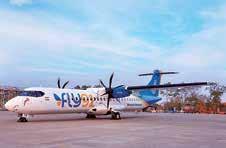
Pratt & Whitney Canada (P&WC) has signed a multi-year engine services agreement with FLY91 for the maintenance, repair and overhaul of the PW127M engines that power its fleet of ATR 72-600 turboprop passenger aircraft. FLY91, India’s new regional airline brand, intends to increase its fleet by the end of 2024 to provide local connectivity to underserved cities in country.
“The agreement with Pratt & Whitney Canada is a significant step in assuring we can provide our customers with dependable regional air travel from our base at Goa’s Manohar International Airport,” said Manoj Chacko, Managing Director and Chief Executive Officer of FLY91.
AMERICAN AIRLINES ORDERS 85 BOEING 737 MAX JETS

Boeing and American Airlines announced that the carrier will further modernise its global fleet with its first order for the largest 737 MAX airplane. American is committing to 115 of the 737-10 model, which includes a new order for 85 jets and a conversion of a previous order for 30 of the smaller 737-8 variant. The airline is also announcing options to purchase 75 additional 737-10 jets in the future.
With this agreement, American will more than double its 737 MAX order book from about 70 airplanes to more than 150, supporting the airline’s long-term growth strategy with highly efficient jets for its domestic and short-haul international network. The 737-10 will complement

EVE ANNOUNCES ANTONIO JOÃO CARMESINI BARCELLOS AS VICE PRESIDENT OF INDUSTRIALISATION
Eve Air Mobility (“Eve”) announced that Antonio João Carmesini Barcellos, current Chairman of the Board and General Director of Embraer Portugal, will be the company’s new Vice President of Industrialisation. With more than 27 years of experience in the aviation industry, Carmesini spent almost eight years as the Director of Manufacturing Engineering at Embraer.

GLOBAL JET CAPITAL APPOINTS MIKE CHRISTIE TO LEAD AMERICAS SALES TEAM
Global Jet Capital has appointed Mike Christie to the position of Head of Sales for the Americas. Most recently, Christie served as Vice President Sales – Western US and Ohio. In his new role, Christie will oversee the company’s sales activities in the United States, Mexico, and Latam. Before joining Global Jet Capital, Mike served in a variety of market-facing sales roles at GE Capital, US Bank, and Huntington National Bank.

BOEING APPOINTS UMA AMULURU AS HUMAN RESOURCES LEADER
Boeing announced Uma Amuluru as the company’s Chief Human Resources Officer and executive vice president, Human Resources, effective April 1. In her new role, Amuluru will be responsible for Boeing’s talent planning, global talent acquisition, learning and development, compensation and benefits, employee and labor relations, and diversity and inclusion initiatives. She will report to Boeing President and CEO David Calhoun and serve on the company’s Executive Council.
American’s current fleet of 737-8 airplanes, allowing the airline to tap into the 737 MAX family’s commonality and flexibility to efficiently meet growing travel demand.
SIRIUS AVIATION PARTNERS WITH MEHAIR
Pioneering Swiss aerospace company Sirius Aviation AG, proudly announced a historic partnership with MEHAIR, India’s pioneering seaplane operator, to secure 50 orders of the Sirius Millennium Jet. This landmark agreement includes 50 firm orders, with an option to add 50 more, totaling approximately $400 million in value. The Sirius Jet, the world’s first hydrogen-powered, zero-emissions, vertical takeoff and landing (VTOL) aircraft, features a high-speed capability, quieter ducted fan jets, and an innovative hydrogen powertrain. This state-of-the-art jet boasts an exceptional range of 1,150 miles– eight times that of traditional eVTOLs, and an impressive speed of 323 mph– three times faster, set to redefine air travel.
Under this historic deal, MEHAIR will oversee the assembly of 50 Sirius Millennium Jets and 1,400 Millennium Hydrogen Fan Jets, along with integrating 50 Hydrogen Fuel Cell Powertrains and 10 Hydrogen Generation Units in India, marking a new era of zero-carbon aviation.
BOEING, THAI AIRWAYS ANNOUNCE ORDER FOR 787 DREAMLINERS

Boeing and Thai Airways announced that the carrier placed an order for 45 787 Dreamliners as the airline looks to modernise and grow its widebody fleet and international network. Thai Airways selected the 787-9 to support its long-term strategy to renew and expand its fleet with more efficient jets, as well as open new routes to support high demand for air travel across Southeast Asia.
Boeing’s 2023 Commercial Market Outlook for Southeast Asia projects that the region’s widebody fleet will see a three-fold increase over 20 years, with growing demand for nearly 800 airplanes including passenger jets such as Boeing’s 787 Dreamliner family and 777X, as well as freighter models.
BRIEFS NEWS 3 SP’S AIRBUZ • ISSUE 2 • 2024 AIRLINES NEWS
ROYAL BRUNEI AIRLINES ORDERS FOUR BOEING 787
Boeing and Royal Brunei Airlines announced the airline’s purchase of four 787 Dreamliners to renew its widebody fleet. Royal Brunei Airlines’ selection of the 787-9 supports the airline’s long-term growth strategy, sustainability goals and focus on passenger comfort.
Royal Brunei Airlines was the first Southeast Asian carrier to fly the 787 Dreamliner over a decade ago. Royal Brunei Airlines currently operates five 787-8s, serving destinations in Asia, Australia, the Middle East and the United Kingdom. The 787-9, which can carry nearly 20 per cent more passengers than the 787-8 and fly 14,010 km (7,565 nautical miles), will support the carrier’s growing capacity needs on these medium- and long-haul routes.
INDUSTRY
WINNERS OF BOEING UNIVERSITY INNOVATION LEADERSHIP DEVELOPMENT PROGRAMME 2023-24 ANNOUNCED

Boeing announced seven teams comprising university students and early-stage start-up entrepreneurs as winners of the third edition of Boeing University Innovation Leadership Development (BUILD) programme 2023-24. Each of these seven teams received INR 10 lakh as a financial grant, and their ideas covered solutions for community development, the defence and space industry, and sustainability.
The seven winning teams are Abyom SpaceTech and Defence Pvt Ltd and Green Aero Propulsion Pvt Ltd from Foundation for Innovation and Technology Transfer (FIIT) – IIT Delhi, Glovatrix Pvt Ltd from Society for Innovation and Entrepreneurship (SINE) – IIT Mumbai, dVerse Technologies Pvt Ltd from IIT Madras Incubation Cell, Backyard Creators Pvt Ltd, BONV Technology Private Limited and Coratia Technologies Pvt. Ltd. from Technology Business Incubator (TBI) – KIIT, Bhubaneswar. These winners will be further supported by Boeing and their respective incubator partners for over a few months to help develop their
PRATT & WHITNEY EXPANDS INDIA OPERATIONS WITH OPENING OF NEW INDIA DIGITAL CAPABILITY CENTER

PRATT
& WHITNEY, AN RTX business, announced the establishment of its new India Digital Capability Center (IDCC) in Bengaluru. The new center will accelerate innovation and drive digital and business transformation for Pratt & Whitney worldwide. The facility will be co-located with Pratt & Whitney’s engineering and supply chain operations centers of excellence. The location will also facilitate close collaboration with other RTX businesses in India including Collins Aerospace and RTX Enterprise Services. Pratt & Whitney has begun recruiting its first tranche of employees for the IDCC and is expected grow to over 300 employees by 2027. The center will be focused on delivering multiple digital technology capabilities across various priority areas of Pratt & Whitney’s digital transformation.
“The expansion of Pratt & Whitney’s digital technology presence in Bengaluru will allow us to leverage India’s aviation and technology talent and accelerate our digital transformation,”
ideas into market-ready and viable business solutions.
“We continue to remain committed to fostering innovation by nurturing the country’s brightest talent and ideas through our industry-academia collaborations and partnerships”, said Salil Gupte, President, Boeing India.
said Rahul Dharni, Vice President & Global Chief Information Officer, Pratt & Whitney. “With $40 million already invested in engineering and supply chain operations centers in the past two years, Pratt & Whitney continues to grow its presence and contribution to India’s aerospace ecosystem with this additional multi-million-dollar investment in the IDCC,” said Ashmita Sethi, President & Country Head, Pratt & Whitney, India.
Pratt & Whitney’s other investments in-country include a state-of-the-art India Customer Training Center in Hyderabad and its research & development collaboration with the Indian Institute of Science, Bengaluru. Pratt & Whitney has sourced nearly $55 million in the past 10 years from leading aerospace suppliers in India and also sourced over $500 million in engineering services into India over the past two decades. With an Indian workforce of more than 5,000 people, RTX has one the largest presences amongst aerospace and defence firms in India. •
Over the years, Boeing India has been helping contribute to skill development and capability building in the country through other programs such as the HorizonX India Innovation Challenge, Accelerated Aircraft Maintenance Engineers Apprenticeship, and National Aeromodelling Competition with IIT.
BRIEFS NEWS 4 SP’S AIRBUZ • ISSUE 2 • 2024 GWWW.SPSAIRBUZ.COM
Rahul Dharni, Vice President & Chief Information Officer, Pratt & Whitney, along with Pratt & Whitney’s Senior Digital Transformation and India Leaders at the inauguration of the Pratt & Whitney India Digital Capability Center in Bengaluru, India
SIKORSKY LOOKS TO FUTURE FAMILY OF VTOL SYSTEMS

Sikorsky, a Lockheed Martin company, unveiled its plan to build, test and fly a hybrid-electric vertical takeoff and landing demonstrator (HEX / VTOL) with a tiltwing configuration.
The design is the first in a series of large, next generation VTOL aircraft — ranging from more traditional helicopters to winged configurations — which will feature varying degrees of electrification, and an advanced autonomy system for optionally piloted flight.
The HEX programme will put a premium on greater than 500 nautical mile range at high speed, fewer mechanical systems to reduce complexity, and lower maintenance costs.
RTX’S COLLINS AEROSPACE INAUGURATES INDIA DIGITAL TECHNOLOGY CENTER
Collins Aerospace, an RTX business, announced the inauguration of the India Digital Technology Center (IDTC), designed to spearhead advancements in digital technology and innovation. The India Digital Technology Center, located in Bengaluru, is strategically positioned to play a pivotal role in Collins Aerospace’s global innovation ecosystem, bringing value through digital initiatives across the globe. The center will specialise in enterprise resource planning, artificial intelligence and machine learning, data engineering and analytics and digital enablement of the product lifecycle. These capabilities set the center apart as a dynamic hub for digital transformation within the company. The center will be co-located with Pratt & Whitney’s India Digital Capability Center, enabling greater cross-enterprise collaboration.
TRAINING
BOEING COLLABORATES WITH AIESL FOR MAINTENANCE TRAINING IN INDIA
Boeing and AI Engineering Services Limited (AIESL) have agreed to work together
to enhance aircraft maintenance training in India. Boeing will provide training materials, aids, and instructor support to help ensure standardisation of AIESL training programmes. AIESL will provide infrastructure and instructors, while securing Civil Aviation Regulation (CAR) 147 approval from the Indian regulatory authority to conduct maintenance training for customers.
Expanding in-country expertise of maintenance employees is critical to meeting strong industry demand for trained maintenance technicians in India. The country will require almost 33,000 pilots and 34,000 maintenance technicians through 2042, according to Boeing’s 2023 Pilot and Technician Outlook. This collaboration will expand local capacity to deliver comprehensive training programmes required for compliance with Directorate General of Civil Aviation (DGCA) CAR-66 regulations. The Boeing – AIESL collaboration will be the latest initiative under the Boeing India Repair Development and Sustainment (BIRDS) hub programme. The BIRDS hub is a local network of suppliers working to build a robust MRO ecosystem for defence and commercial aircraft.
CARGO
FIRST E-JET CONVERTED TO TRANSPORT CARGO AIRCRAFT MAKES ITS DEBUT

The first E190F, a converted jet from passenger transport to freighter (E-Freighter), has successfully completed its first flight. The Embraer team flew the E-Freighter jet for around two hours, carrying out a complete evaluation of the aircraft, which will continue testing before entering operation. The first flight is part of a series of evaluations that Embraer is conducting before the E-Freighter jets enter into operation. The aircraft has already been successful in both ground pressurisation and cargo loading tests.
E-Jets converted to freighters will have over 50 per cent more volume
capacity, three times the range of large cargo turboprops, and up to 30 per cent lower operating costs than narrowbodies. If combining capacity under the floor and main deck, the maximum structural payload is 13,500 kg for the E190F and 14,300 kg for the E195F. Launched in 2022, the E190F and E195F Passenger to Freight Conversions (P2F) programme involved a global network of more than 40 suppliers and more than 600 employees that dedicated more than half a million hours to the E-Freighter.
INFRASTRUCTURE
AIRBUS’S A220 DOOR MANUFACTURING UNDER ‘MAKE IN INDIA’
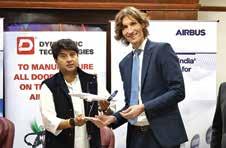
Union Minister of Civil Aviation, Jyotiraditya M. Scindia unveiled Airbus’s significant expansion in its ‘Make in India’ initiative during a momentous event. Airbus and Dynamatic Technologies have joined hands to manufacture all doors for the single-aisle A220 family aircraft in India. Talking about the new manufacturing facility Scindia said, “India is steadily becoming a destination for aerospace manufacturing across the world, the largest order for the aircraft doors to Dynamatic technologies which is already working with Airbus is a great moment in Prime Minister’s resolve for make in India.”
With a range of up to 3,600 nautical miles (6,700 km) and seating capacity ranging from 100 to 160 passengers, the A220 is ideally suited for India’s UDAN (UdeDesh ka Aam Nagrik) scheme, aimed at enhancing regional connectivity and promoting economic growth across the nation. The Dynamatic Technologies manufacturing facility of all doors for the single-aisle A220 family aircraft will offer an incredible opportunity for Indian private sector to enter a technologyintensive and highly competitive aviation industry. Additionally, it will elevate domestic manufacturing capabilities leading to reduced import dependence and increased exports. •
BRIEFS NEWS 5 SP’S AIRBUZ • ISSUE 2 • 2024

INNOVATIONS TO REVOLUTIONISE AIR FREIGHT
BY ROHIT GOEL
THE SKIES ARE NO longer just for passenger planes. A revolution is brewing in the air cargo industry, with companies developing solutions for autonomous delivery of goods. These innovative players aim to transform logistics, offering faster, cheaper, and more sustainable transportation options. Traditionally dominated by passenger flights, the airspace is now becoming a frontier for innovative companies pioneering autonomous delivery solutions. These autonomous delivery solutions promise a multitude of
The development of autonomous air cargo solutions opens a treasure trove of opportunities with the potential to reshape the landscape of global logistics
advantages, with speed, cost-effectiveness, and sustainability at the forefront. The implementation of such technologies aims to streamline the logistics process, offering faster delivery times that can significantly benefit various industries. The reduced need for human intervention also contributes to cost savings, making these solutions more economically viable in the long run.
In addition to the economic advantages, the integration of autonomous air cargo solutions addresses environmental concerns by providing a more sustainable alternative to traditional
SP’S AIRBUZ • ISSUE 2 • 2024 GWWW.SPSAIRBUZ.COM 6 TECHNOLOGY AIR CARGO
PHOTOGRAPH Droneliner
Droneliner Autonomous Drone Cargo Planes: Regulatory frameworks are adapting to accommodate autonomous cargo flights, with aviation authorities worldwide working on guidelines and standards for safe integration into airspace
transportation methods. Electric-powered drones and other ecofriendly technologies are being incorporated into these systems, contributing to a reduced carbon footprint compared to conventional cargo planes or ground transportation.
Regulatory frameworks are adapting to accommodate these advancements, with aviation authorities worldwide working to establish guidelines and standards for the safe integration of autonomous cargo flights into airspace. This regulatory evolution is a crucial aspect of ensuring the responsible deployment of these technologies.
EXCITING OPPORTUNITIES. The development of autonomous air cargo solutions brings forth numerous exciting opportunities, poised to revolutionise the logistics landscape across various key areas. Firstly, in terms of speed and efficiency, drones have the potential to significantly reduce delivery times by bypassing congested ground routes and efficiently navigating through airspace. This capability is particularly beneficial for time-sensitive goods such as medical supplies, fresh produce, and critical industrial components. Moreover, the use of autonomous drones can enhance access to remote areas, reaching places like mountainous regions, islands, and disaster zones for faster delivery of essential goods and humanitarian aid. The dynamic route planning and on-demand scheduling capabilities of drones also offer the opportunity to optimise delivery networks, increasing overall efficiency and reducing transportation costs.
In terms of cost-effectiveness and sustainability, the adoption of autonomous air cargo solutions presents various advantages. While the initial investment may be high, long-term operational costs can be lower, with the elimination of pilot salaries and associated training costs, optimisation of fuel consumption compared to traditional air cargo planes, and reduced maintenance require-
ments of simpler drone designs. The environmental benefits of electric and hybrid-powered drones include quieter operation and lower emissions, contributing to a more sustainable future for logistics. Additionally, the affordability of air cargo solutions can open up new markets for small and medium enterprises in remote regions, fostering global trade and economic growth.
Unlocking new business models and services is another exciting aspect of autonomous air cargo. Drones enable on-demand, instant delivery of essential goods for local communities, creating new business opportunities for retailers and service providers. Specialised delivery solutions can be tailored to specific industries with niche needs, such as transporting medical samples, delivering valuable artwork, or providing emergency response services. Real-time data collected by drones can be leveraged for data-driven logistics, optimising supply chains, predicting demand, and improving overall efficiency.
Furthermore, the development of autonomous air cargo is set to boost innovation and collaboration. The demand for such solutions will drive technological advancements in areas like battery technology, sensor fusion, and artificial intelligence, benefiting industries beyond logistics. Collaboration between startups, established logistics companies, aerospace manufacturers, and research institutions is crucial for driving innovation and realising the full potential of this technology. The global impact of efficient and affordable air cargo solutions extends to contributing to global economic development by connecting remote communities, facilitating international trade, and enhancing overall supply chain resilience.
CHALLENGES GALORE. The landscape of autonomous air cargo solutions is riddled with a myriad of challenges, each requiring careful consideration for the successful integration of this innovative technology. Regulatory uncertainties pose a sig-

SP’S AIRBUZ • ISSUE 2 • 2024 7
AIR CARGO
TECHNOLOGY
MightyFly Autonomous Flight Success Paves the Way for Efficient Cargo Loading and Unloading
PHOTOGRAPH MightyFly

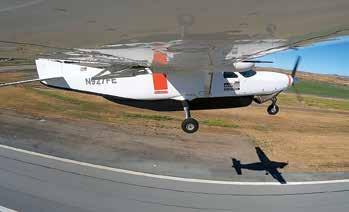
nificant hurdle, with unclear rules and regulations surrounding unmanned aerial vehicles (UAVs), particularly for larger cargo drones. This lack of clarity creates uncertainty for companies regarding airspace access, operational restrictions, and certification requirements. Additionally, the slow pace of regulatory updates and differing regulations across countries further complicate cross-border operations, necessitating complex compliance efforts.
Safety concerns add another layer of complexity, as worries persist about potential collisions with other aircraft, buildings, or people. Reliable collision avoidance systems utilising LiDAR, radar, and advanced algorithms become crucial, along with comprehensive emergency protocols to address situations like engine failure, battery malfunctions, or cyberattacks. Cybersecurity threats pose a specific risk, with the vulnerability of autonomous drones to malicious attacks that could compromise flight control systems or manipulate data. Robust cybersecurity measures and secure communication protocols are imperative to safeguard operations.
Technological limitations, such as battery and sensor constraints, need to be overcome for the full potential of autonomous air cargo to be realised. Current battery technology restricts range and payload capacity, demanding advancements for extended flight times and heavier cargo deliveries. Improved sensor capabilities are necessary for reliable navigation and obstacle avoidance in challenging environmental conditions. While autonomous flight systems are progressing, further automation efforts are required for truly autonomous end-to-end operations.
Infrastructure bottlenecks pose practical challenges, with a lack of dedicated landing and take-off infrastructure limiting convenient access for cargo loading and unloading. Efficient ground handling procedures, along with automated systems and standardised protocols, need to be established. Compatibility with existing airport and logistics infrastructure is crucial for seamless integration, requiring standardised communication protocols and data exchange formats for coordinated operations.
The integration with existing systems, including air traffic control and logistics management platforms, demands efficient communication and compatibility. Security protocols must align with existing transportation and aviation security measures to ensure cargo safety and prevent unauthorised access.
The economic viability of autonomous air cargo is a central concern, given the high initial investment required for research,
development, manufacturing, and infrastructure. Optimising operational costs becomes essential for competing with established and cheaper transportation options, necessitating considerations such as battery charging, maintenance, and airspace fees. Identifying revenue streams and building sustainable business models beyond offering faster delivery at a premium is crucial for long-term success.
Weather dependence introduces an additional layer of complexity, with adverse weather conditions impacting drone operations and potentially causing delays or cancellations. Developing weather-resistant technology, robust flight planning algorithms, and real-time weather forecasting capabilities are crucial for reliable delivery performance. Also, the overarching cybersecurity threats, encompassing vulnerability to cyberattacks and data security concerns, underscore the need for robust cybersecurity measures, encrypted communication protocols, and the development of cyber resilience strategies.
Public acceptance emerges as a multifaceted challenge, with varying attitudes towards drone technology, concerns about noise pollution, privacy, and safety potentially hindering widespread adoption. Public education and communication campaigns are crucial for generating understanding, addressing anxieties, and highlighting the potential benefits of autonomous air cargo.
By acknowledging and addressing these numerous challenges, stakeholders in autonomous air cargo can pave the way for a future where this innovative technology revolutionises global goods movement, delivering on its promise of speed, efficiency, and sustainability.
Autonomous delivery solutions offer advantages such as speed, cost-effectiveness, and sustainability by streamlining logistics, reducing human intervention, and incorporating eco-friendly technologies like electric-powered drones
SP’S AIRBUZ • ISSUE 2 • 2024 GWWW.SPSAIRBUZ.COM 8 TECHNOLOGY AIR CARGO
PHOTOGRAPHS :
(Left) Elroy Air specialises in aircraft tailored specifically for cargo delivery; (Right) Reliable Robotics demonstrates uncrewed flight of a large cargo aircraft.
Elroy Air, Reliable Robotics
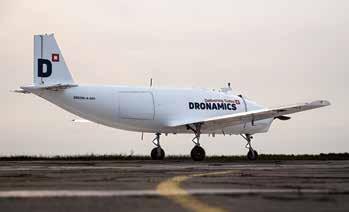


LEADING THE CHARGE. In the realm of autonomous air cargo delivery, several companies are at the forefront, pioneering innovative technologies and achieving significant milestones. Dronamics is on a mission to change the way the world thinks about cargo delivery and are building an air cargo ecosystem to serve the needs of people and industries in all corners of the planet. A mobility solution powered by long-range cargo drones that saves time, costs and carbon emissions.
Taking a distinctive approach, Natilus focuses on the development of autonomous cargo seaplanes. Operating at low altitudes, these amphibious drones present the potential to navigate regulatory challenges more seamlessly. Natilus sets itself apart with a hybrid-electric propulsion system, ensuring quieter and more environmentally friendly operations. The company’s commitment to innovation is reflected in its pursuit of unconventional solutions for the autonomous cargo delivery landscape.
Elroy Air, a Silicon Valley startup, specialises in the design and construction of autonomous vertical take-off and landing (VTOL) aircraft tailored specifically for cargo delivery. The Condor drone, a creation of Elroy Air, boasts an impressive capacity to carry up to 500 pounds over distances exceeding 300 miles. This capability positions it as an ideal solution for short-haul and middle-mile logistics, contributing to the advancement of efficient and autonomous cargo transportation.
Zipline, renowned for its expertise in medical drone deliveries, is expanding its footprint in the broader air cargo market. Operating fixed-wing drones in Rwanda and Ghana, Zipline has successfully delivered critical supplies such as blood and vaccines. Leveraging their proficiency in long-range autonomous flight, Zipline is poised to play a pivotal role in the broader application of cargo delivery, emphasising the potential for transformative impact beyond medical logistics.
One notable player in this space is Xwing, a California-based company that has positioned itself as a leader in the development of autonomous cargo aircraft. Xwing’s groundbreaking “Superpilot” system stands out for its ability to retrofit existing planes, such as the Cessna 208B Grand Caravans, enabling them to fly autonomously. In a monumental achievement in 2021, Xwing successfully executed the world’s first autonomous gate-to-gate cargo flight, showcasing the practical application and viability of their cutting-edge technology.
Embark Aeronautics, an Israeli company, introduces a modular approach to autonomous cargo delivery. Their inno-
vative design focuses on interchangeable cargo pods that can be attached to various aircraft types. This adaptability not only enhances versatility but also allows them to cater to different needs and payload capacities, making their system potentially more flexible for diverse logistics operations.
In addition to individual efforts, collaborations and partnerships are integral to advancing autonomous air cargo technology. Boeing and Kitty Hawk, through their joint venture, are actively developing electric VTOL aircraft for urban air mobility, a technology that could extend its applications to air cargo delivery. Airbus and Deutsche Post DHL are collaborating on the “AirMule” project, exploring the use of drones specifically for delivering urgent and time-sensitive cargo. As companies collaborate, compete, and learn from each other, the technology will evolve at an incredible pace. Governmental agencies like NASA and the FAA in the United States are actively involved in shaping the regulatory landscape and safety protocols for autonomous flight. Their contributions are essential for ensuring the safe and widespread adoption of this transformative technology.
As various companies and collaborative efforts continue to push the boundaries of autonomous air cargo delivery, the industry stands on the cusp of a revolutionary transformation, with the potential to reshape the future of logistics on a global scale.
CONCLUSION. This is just a glimpse into the exciting world of autonomous air cargo. The ongoing revolution in the air cargo industry driven by autonomous delivery solutions is reshaping the landscape of logistics. With companies investing in cutting-edge technologies and regulatory bodies adapting to the changing dynamics, the skies are poised to become a bustling domain for autonomous cargo transportation, offering faster, cheaper, and more sustainable options for the movement of goods. The implications of this transformation extend beyond just business efficiency, influencing global supply chains, environmental impact, and the accessibility of essential services in remote areas.
The autonomous air cargo industry is still in its early stages, but the potential is undeniable. Continued innovation, collaboration, and regulatory progress, will revolutionise the way these flying machines move goods in the years to come. As the technology matures, it will be fascinating to see how these companies adapt and evolve, shaping the future of logistics and creating a truly interconnected and efficient global supply chain. The future of logistics is taking flight, and it’s going to be a wild ride! SP
SP’S AIRBUZ • ISSUE 2 • 2024 9 TECHNOLOGY AIR CARGO
(Left) Dronamics is called The World’s First Cargo Drone Airline; (Right) Natilus Says New Autonomous Aircraft To Enhance Rapid and Safe Logistics in Africa. PHOTOGRAPHS : Dronamics, Natilus
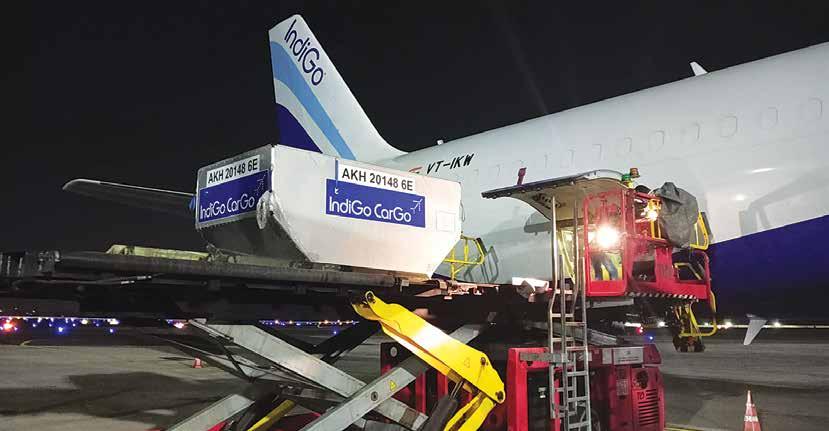
INDIA ON PATH TO BECOME MOST PROMISING AIR CARGO MARKET IN 2024
BY SWAATI KETKAR
AIR CARGO, THE RELATIVELY smaller cousin of commercial aviation has slowly and steadily made its mark as one of the most essential mediums of transporting goods and services. Rarely do we stop to appreciate the logistics, the workforce behind this huge industry that ensures most of our basic amenities reach us on time. In this article we will catch a glimpse of India’s blud-
India is rapidly making huge strides in technology, machinelearning, AI, infrastructure, partnerships and overseas shipments of varying sizes and volume, that are propelling India to become the most promising markets in terms of air cargo industry.
geoning air cargo market, its size, freighter fleet, technological advancements and much more…
On one hand as the global Air Cargo market is anticipated to grow at a considerable rate between 2024 to 2031, India has grabbed this opportunity by both hands to not just develop but become one of the top five freight markets by 2025 and has set an ambitious target of 10 million tonnes for Indian air cargo to
SP’S AIRBUZ • ISSUE 2 • 2024 GWWW.SPSAIRBUZ.COM 10 INDUSTRY ANALYSIS AIR CARGO
The emergence of new freighter airlines in India signals a positive trajectory for the air cargo sector, driven by increasing demand for efficient and reliable cargo services.
PHOTOGRAPH IndiGo6E / X
achieve by 2031 from the current 3 million tonnes. The government is doing everything in its power to make this a reality.
According to the recent forecast by Research and Markets, India’s Air Freight Market is estimated to be $13.08 billion in 2023 and is expected to reach $17.22 billion by 2028, growing at a CAGR of 5.65 per cent.
GLOBAL AIR CARGO MARKETS ENTER 2024 WITH CAUTIOUS OPTIMISM, INDIA MARCHES HEAD-ON WITH RESILIENT PERFORMANCE.
However, Xeneta advises the global air cargo industry to enter the year 2024 with cautious optimism. Analysing the 2024 market further Niall van de Wouw, Xeneta’s Chief Airfreight Officer says that calling 2024 as the new dawn for air cargo would be too optimistic but it is the start of a new cycle for airline, forwarders and shippers. “They are appreciating the stability returning to the market so they can more accurately predict the transportation costs for the products they are selling.”
As compared to global air cargo industry, the Indian air cargo sector has faired really well, claims industry experts. Most of the Indian air freighters anticipate a more resilient performance going ahead in 2024. “At Continental, we believe the air cargo sector has seen immense growth in 2023, yet challenges such as subdued demand during peak seasons and concerns over elevated airfares evident,” says Vaibhav Vohra, Managing Director at Continental Carriers. “Despite a dip in air cargo during festive peak times and uncertainties surrounding sustained higher prices as potential hurdles, we anticipate a more resilient performance in 2024,” he further adds.
Further elaborating his point with examples Vohra continues to state various factors leading to his optimistic outlook. Some of those factors are
l The anticipated acceleration of global economic recovery is poised to drive increased demand for cross-border goods transportation.
l As businesses rebound from the challenges of the previous year, there is a projected surge in trade activities, inherently amplifying the demand for air cargo services.
l Industry’s unwavering commitment to sustainable practices and the integration of eco-friendly technologies align seamlessly with broader global trends.
This dedication holds the potential to attract businesses actively seeking environmentally conscious transportation options, further fortifying the positive outlook for the air cargo sector in 2024.
Vohra’s opinion is seconded by Keku Bomi Gazder, Managing Director & Chief Executive Officer at AviaPro Logistics Services
India’s air cargo industry is experiencing significant growth. This growth is projected to continue, with India aiming to become one of the top five freight markets by 2025 and achieve 10 million tonnes of air cargo by 2031.
CARGO CARRIED (TONNE)
Source: DGCA
Pvt Ltd. “Despite a lukewarm 2023, I am cautiously optimistic about the air cargo sector’s performance in 2024,” Gazder adds thoughtfully. Speaking about his strategies in 2024 to tackle various challenges he adds, “Our strategy involves a multi-faceted approach. We anticipate a gradual recovery as global economic conditions improve,”
The increasing globalisation and e-commerce trends offer growth opportunities. “However, we acknowledge potential headwinds, such as fuel price volatility and geopolitical uncertainties. Rigorous cost management, route optimisation, and customercentric services will be our focus areas to ensure a positive outcome,” Gazder further adds.
“The air cargo industry in India has demonstrated remarkable performance in the year 2023, and the outlook for 2024 is equally promising,” says Anto Bright, Founder-Owner of SKYBHEX, an independent cargo charter service provider. He further goes on to praise New Logistics Policy and PM Gati Shakti that has placed India in a favorable position to become a leading global logistics hub.
India’s strategic regulatory reforms and infrastructure development initiatives, including the affordable and efficient solutions offered by the country, which align with sustainable practices, are undoubtedly contributing to its steady growth in the industry.
AIR CARGO AND TECHNOLOGY. The air cargo industry in India is undergoing a significant technological transformation, placing sustainability at the forefront of supply chain management. This shift is characterised by innovations and advanced logistics solutions aimed at boosting operational efficiency, cutting costs, and enhancing overall competitiveness.
Key technologies like Artificial Intelligence (AI), the Internet of Things (IoT), Blockchain, and Machine Learning are poised to redefine logistics practices, ushering in a more eco-friendly and efficient future. This has enabled better tracking and visibility of goods, reduced waste and emissions, and improved efficiency. These technological advancements have facilitated better tracking of shipments, reduced transit times, and optimised routes ultimately leading to reduced fuel consumption and emissions.
Speaking about modern & smart warehouses Vohra stresses the need and importance of sustainability that is gaining global prominence. “At Continental, our strategic initiatives include collaborating with customs authorities for efficient customs deployment at our Air Freight Station (AFS).” Vohra also plans to implement a Customer Relationship Management (CRM) system to enhance their ability to track client interactions and preferences. “This system aligns with our commitment to excellence and sus-
SP’S AIRBUZ • ISSUE 2 • 2024 11
ANALYSIS AIR CARGO
INDUSTRY
Year Domestic Services International Services Total Scheduled & Non Scheduled Scheduled & Non Scheduled Scheduled & Non Scheduled 2021 6,94,709.10 2,07,070.50 9,01,779.60 2022 7,37,620.20 2,26,629.90 9,64,250.10 2023 7,51,605.12 2,15,606.30 9,67,211.42
tainability in the evolving landscape of the air cargo industry,” Vohra further adds.
Gazder also stresses importance on the adoption of cuttingedge supply chain management tools. “Blockchain ensures transparency and security in transactions, while data analytics enables us to make informed decisions.” Attaching exceptional importance sustainability, Gazder adds “Sustainability is a prime focus, with investments in fuel-efficient aircraft, green packaging, and environmentally conscious operational practices.”
Bright explains this with an example. Today, cargo containers are installed with IoT sensors to provide real-time information on location, temperature, and humidity, ensuring the quality and safety of the cargo. Furthermore, blockchain technology provides a transparent and secure system for monitoring the movement of goods, reducing the risk of fraud, and ensuring compliance with sustainability regulations. AI can assist businesses in responding to disruptions with agility, making them more resilient and more carbon efficient.
Thus, with the entry of advanced technologies like artificial intelligence, IoT, cloud computing, robotics, and blockchain in supply chain management, the future of the industry looks promising.
IS INDIA TECHNOLOGICALLY AT PAR WITH THE GLOBAL AIR CARGO INDUSTRY?
Indian air cargo industry has made remarkable strides in aligning its air cargo industry with global technological standards. India’s transformative journey over the past few years is evident in its rapid technological development and heightened industry awareness. Vohra claims that at present, the air cargo business in India stands as one of the most competitive and fastest-growing segments, projecting a bright future.
still has a long way to go, “While India has made commendable progress in adopting technology, we recognise the need for further advancements to align with global standards,” Gazder assets. Explaining his point with an example Gazder adds that initiatives like AI integration for predictive analytics, automation in cargo handling for efficiency, and robotics to streamline operations need to be integrated in India’s supply chain. He further goes on to advice India’s cargo players to collaborate with technology partners and increased investment in R&D as it will eventually be pivotal in ensuring that India remains technologically competitive.
Echoing Gazder views Bright confirms that although India has made significant progress in recent years in the air cargo sector, it still has a long way to go to be at par with the global air cargo industry. “India is facing challenges like outdated infrastructure, lack of automation, and complex regulatory procedures,” Bright adds. He further lays emphasis on various government schemes
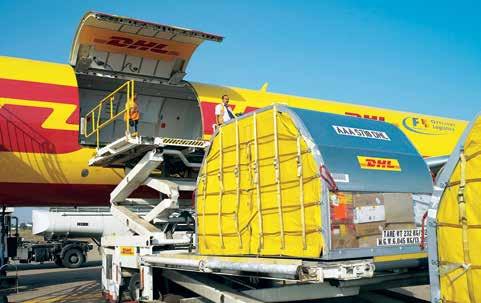
According to a recent report by Research & Markets, in a significant leap in India’s air cargo market, is estimated to reach $17.22 billion by 2028, growing at a commendable CAGR of 5.65 per cent. This surge is attributed to strategic initiatives focusing on the development of airport infrastructure, logistics parks, and extensive road connectivity projects across the nation. The production-linked incentive (PLI) scheme covering 15 manufacturing sectors further adds impetus to the growth of air cargo operations in India.
Technological advancements have played a pivotal role in streamlining previously cumbersome processes, rendering them efficient, swift, and virtually error-free. Vohra states that in today’s times traditional modes of cargo transportation are giving way to modern, technologically advanced methods, marking a significant shift in the industry landscape. Its influence spans from revenue management to the formulation of rules and regulations for warehouses.
Vohra further hails technology to reduce errors and places a heightened emphasis on customer-oriented operations and relations. However, going a step ahead, Gazder feels that India
and initiatives to address the above issues.
With the implementation of recent technologies and process improvements, India is expected to catch up with the global air cargo industry in the coming years and carve a niche for itself on the global stage as an emerging leader in the air cargo industry.
CURRENT CHALLENGES GRAPPLING THE AIR CARGO SECTOR.
In 2024, the air cargo sector in India faces several challenges that necessitate strategic attention. The challenges range from rising fuel prices to security concerns, inventory management policies, competition from other modes of transport, and industry consolidation.
l Some specific challenges facing the air cargo sector include inefficient infrastructure, lack of proper technology, high operational costs, and the need for a skilled workforce.
l Bright points the attention to regulatory challenges such as complex customs procedures and restrictions on exports and imports.
SP’S AIRBUZ • ISSUE 2 • 2024 GWWW.SPSAIRBUZ.COM 12 INDUSTRY ANALYSIS AIR CARGO
PHOTOGRAPH DHL
Partnerships with major e-commerce players are positioning Indian air cargo stakeholders to capitalise on the booming APAC e-commerce market
l The issue of grounded unsafe aircraft is a significant concern, impacting financial performance and operational reliability across the industry.
l Vohra signals one of the major challenges as supply chain disruptions that pose additional hurdles, affecting the timely delivery of aircraft and creating bottlenecks in meeting the increasing demand for air cargo services. Gazder also asserts that global supply chain disruptions and geopolitical uncertainties continue to impact operations.
l The emerging duopoly in the Indian aviation market, dominated by key players, raises structural concerns that may limit healthy competition and innovation.
l Moreover, India’s low per-capita penetration of domestic air cargo signals a gap in realising the full potential of the domestic air market compared to its global counterparts.
l Challenges such as inflated growth projections, tough
significant growth and transformation, with a strong focus on technology and innovation. Some of the common trends seen across the globe in air cargo space are
l One of the latest and most promising trends in the industry is the implementation of blockchain technology to increase transparency and security in the supply chain. This innovative technology has the potential to revolutionise the way cargo is tracked, monitored, and delivered, and is already being adopted by leading players in the industry.
l Bright places sustainability as one of the most trending air cargo practices. “There is a growing emphasis on sustainability, with a shift towards cleaner and more eco-friendly technologies including the use of electric and hybrid vehicles, adoption of green logistics practices such as carbon offsetting and waste reduction, green packaging initiatives, fuelefficient fleet management and much more,” Bright adds.
l The rise of drone delivery services,

entry barriers, high fuel prices due to excessive taxes, and outdated aviation regulations further impede sector growth. Addressing these multifaceted challenges collectively is crucial for the air cargo sector to thrive in the evolving landscape of 2024.
Addressing these challenges requires collaboration with regulatory bodies, investments in infrastructure, and a proactive approach to talent development. However, the Indian government and the industry have taken initiatives to address these issues coupled with recent technologies and process improvements, India’s air cargo industry is predicted to grow by leaps and bounds in the upcoming years, allowing it to catch up with the global market.
LATEST TRENDS IN AIR CARGO INDUSTRY. The
Indian air cargo industry is driven by high demand in allied sectors such as e-commerce, pharmaceuticals, manufacturing, electronics and agriculture and is currently experiencing a period of
l AI and automation integration like leveraging AI for predictive demand forecasting
l The industry is increasingly adopting automation and artificial intelligence to improve efficiency and reduce costs. This includes the use of advanced analytics, predictive modeling, and robotic process automation, among other technologies.
l Improved cargo tracking and use of advanced cargo handling technologies like robotic automation,
l Cybersecurity measures and revamped supply chain strategies are just some of the trends reshaping the skies of air shipping.
“Embracing these changes will not only drive economic growth but also ensure that the industry navigates toward a greener and more efficient future,” says Vohra.
“We are at the forefront of industry trends and recent collaborations with digital platforms have ensured end-to-end visibility enhancing operational efficiency and customer satisfaction,” affirms Gazder.
Overall, the Indian air cargo industry is poised for continued growth and transformation, with a range of exciting and innovative trends driving the industry forward, and as consumers and businesses continue to demand faster, safer, and more sustainable shipping solutions, the air shipping industry must rise to the occasion and embrace innovation to stay ahead in this everevolving landscape.
EMERGENCE OF NEW FREIGHTERS IN INDIA.
Interestingly India witnessed the rise of many new freighter airlines like Pradhaan Air Express, IndiGo CarGo (the cargo arm of IndiGo), SpiceXpress (independent cargo arm of SpiceJet) and QuikJet. “The emergence of new freighter airlines in India signals a positive trajectory for the air cargo sector,” Vohra exclaims excitedly while Gazder calls it a dynamic development.
SP’S AIRBUZ • ISSUE 2 • 2024 13
AIR
INDUSTRY ANALYSIS
CARGO
/ X
Despite facing resistance, the Indian air cargo industry is poised for continued growth, with a focus on technology and innovation to address these challenges PHOTOGRAPH aairedner
The demand for efficient and reliable cargo services is on the rise, and these new entrants have the potential to cater to this demand. The success of these new freighters however hinge on their ability to navigate operational challenges, leverage modern technologies, regulatory compliances and adapt to market dynamics. Gazder shares his mantra for the success of these airlines. “We believe innovative service offerings, and operational reliability will set the foundation for success. As a mature player, we closely monitor these developments and remain adaptable to evolving market dynamics,” he adds. All-in-all, a strategic approach, customer-centric services, and agility will be key factors determining their success shortly.
Further there is no denying the fact that Indian market is ripe for the rise of new entrants in air cargo sector. “As more consumers turn to online shopping, the need for timely delivery of goods becomes increasingly crucial. This could create new opportunities for freighter airlines that can offer reliable and cost-effective services,” adds Bright.
However, the competition in this market is intense, with established players already holding a lion’s share of the market. “Therefore, it will be essential for new entrants to differentiate themselves and provide unique services if they hope to succeed in this area,” advises Bright. It will be fascinating to witness how
Initiatives like AI integration for predictive analytics, automation in cargo handling, and robotics are essential for India’s competitiveness in the global market
this market will evolve over time and how new airlines will create a space for themselves in this competitive landscape.
THE ROLE OF GOVERNMENT IN PROMOTING INDIA’S AIR CARGO INDUSTRY.
The Indian Government is taking ample steps to ensure that air cargo industry is getting the right leverage that it needs to expand and grow not just in domestic market but also globally. However, Vohra feels that a strategic and interconnected approach is vital. “Prioritise substantial investments in upgrading air cargo infrastructure andmodernising airports to meet growing demands effectively is the need of hour,” Vohra adds.
INFRASTRUCTURE DEVELOPMENT.
Bright throws light on the development of Grade A warehouses that can significantly impact the logistics and supply chain industry in India. Grade A warehouse is a modern, high-quality facility designed to meet international standards for storage and distribution. These warehouses are typically equipped with advanced technologies such as inventory management systems, automated storage and retrieval systems, and temperature control systems to ensure the safety and security of goods while in transit.
“Investing in Grade A can help reduce the risk of damage or theft of goods during transportation, as these warehouses are
designed to be more secure and equipped with surveillance systems. Secondly, it can help streamline operations by providing easy access to inventory, thereby improving efficiency and reducing costs,” Bright asserts.
“Moreover, developing Grade A warehousing can also attract more investors and businesses to the region, as it signals a commitment to modernising and upgrading logistics infrastructure. This can help boost the local economy by creating jobs and driving economic growth,” Bright further adds.
Overall, investing in Grade A warehousing can help improve the quality of cargo operations in India, making it a more attractive destination for businesses and investors alike. Vohra further adds that government should streamline customs procedures, minimise bureaucratic hurdles, and implement transparent policies for swift clearance. Bright echoes this sentiment, he says that government can implement reforms like reducing taxes and customs duties on cargo shipments making it more affordable and attractive for businesses to use air freight services, increasing demand for air cargo carriers.
“The government can play a pivotal role by investing in infrastructure development, streamlining regulatory processes, and offering incentives for the adoption of sustainable practices,” Gazder suggests. “I actively engage with government bodies to advocate for policies that foster industry growth. Our recommendations include incentivising investments in modern infrastructure, streamlining bureaucratic processes, and offering tax incentives for sustainable practices.”
“Public-private partnerships are crucial, and we collaborate with the government to create an environment conducive to the longterm development of the air cargo industry,” Gazder concludes.
Government should also provide financial incentives, adds Vohra. Vohra suggests the following steps to be taken by the government to make the sector financially strong and self-reliant.
l Introduce incentives for businesses contributing to air cargo infrastructure, technology, research and development and workforce training.
l Provide tax breaks to airlines and logistics companies supporting sector growth. Implement strategic policies for market access and open skies agreements.
l Negotiate open skies agreements with key partners and explore alliances with global cargo operators to enhance the reach and competitiveness of the Indian air cargo industry.
This comprehensive and efficient approach, blending infrastructure development, regulatory efficiency, technological innovation, financial incentives, and strategic partnerships, will foster the exponential growth of India’s air cargo industry and facilitate seamless global trade.
Going ahead, the exponential growth in the APAC e-commerce market, particularly in India, is a significant opportunity for air cargo operations. “We are aligning our strategies to cater to the specific logistics needs of e-commerce, ensuring seamless last-mile deliveries, and leveraging technology for real-time tracking and order fulfillment,” Gazder says. “Collaborative partnerships with major e-commerce players position us to capitalise on this booming market,” Gazder signs off.
All-in-all it is safe to say that air cargo industry’s prospects for 2024 are positive and encouraging. However, India still lacks in long-distance cargo shipments to US and Europe where foreign carriers have forged their mark. India’s air cargo stakeholders with new players and new orders need to break this trend and venture boldly into international space in times to come. SP
SP’S AIRBUZ • ISSUE 2 • 2024 GWWW.SPSAIRBUZ.COM 14 INDUSTRY ANALYSIS AIR CARGO
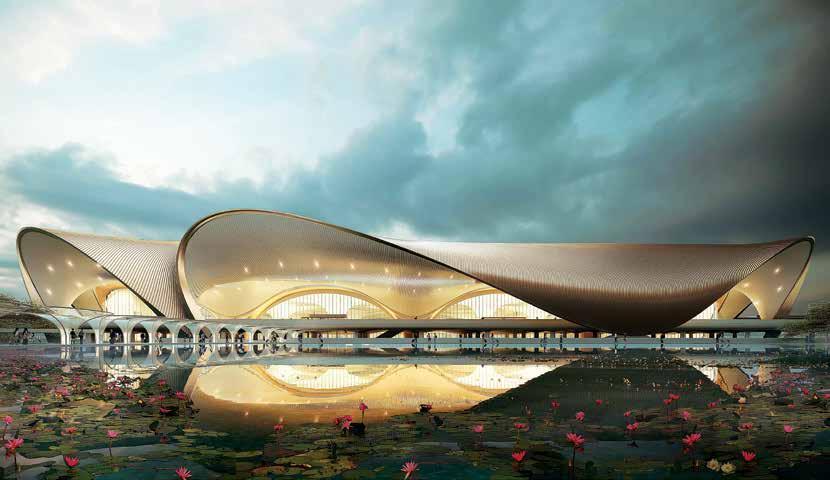
CHARTING A GREENER FUTURE
BY SWAATI KETKAR
HAVE YOU EVER VISITED a greenfield airport under construction right in your backward? Well, I have, and trust me the experience is mind-boggling. Boasting of being India’s very first airport with sustainable aviation fuel fueling and refueling capability, the Navi Mumbai International Airport Limited (NMIAL) project worth eighteen thousand crores is anticipated to be a game-changer for trafficheckled passengers of Mumbai and Navi Mumbai.
Navi Mumbai International Airport is redefining aviation excellence by pioneering sustainability, innovation, connectivity and economic growth
The airport spread over 1,160 hectares of land and located approximately 35 km from Mumbai Airport will have four passenger terminals, one dedicated general aviation terminal, one cargo terminal, two parallel runways – 3,700m long and 60m wide and spaced 1.55 km apart and at least 42 aircraft parking areas in the first two stages and 245 aircraft stands in the remaining three stages. The airport is expected to create over four lakh job opportunities.
SP’S AIRBUZ • ISSUE 2 • 2024 15 NAVI MUMBAI AIRPORT AIRPORTS
India’s Pioneering Sustainable Aviation Hub: Navi Mumbai International Airport takes flight PHOTOGRAPHS : NMIAL

SUSTAINABILITY & NMIAL. The airport management is currently in talks with various SAF manufacturing companies based in India like Praj Industries, IOC, BPCL and many more, but a final deal is yet to be signed. India is currently facing the challenge of garnering adequate feedstock for SAF production. Due to less produce, naturally the SAF rates are much higher than normal ATF making life more difficult for operators.
However, experts are of the opinion that India has abundant feedstock as compared to west and very soon India will emerge as the one of the biggest producers of SAF. Eyeing this forecast, the airport management has allotted considerable space for SAF storage.
Speaking of sustainability, the NMIA has kept the natural water reservoirs like ponds and lakes in the airport vicin-
Boasting of being India’s very first airport with sustainable aviation fuel fuelling and refuelling capability, the Navi Mumbai International Airport Limited (NMIAL) project worth eighteen thousand crores is anticipated to be a gamechanger
ity intact to source water for construction and later for human consumption.
The complete planning of the airport is done in such a way that it will be highly eco-friendly and energy-efficient. The operations of the airport will depend on the on-site solar power generation. Another interesting fact is that only electric vehicles will be permitted inside the vicinity of the airport and solar-panelled rooftops for all terminals, keeping sustainability at the core of its operations.
Besides right at the construction phase, there are huge storage tanks for rainwater harvesting along with recycling wastewater and organic waste.
THE STRUCTURE & OPERATIONS. The airport construction was approved in 2017 but the actual construction work commenced in 2021 after Adani Group took over from GVK Group. Since 2018, the work was hit by various hurdles like litigations and land acquisition delays. The northern part of the planned site was full of swampy marine soil, which had to be raised to prevent flooding. Additionally, another significant obstacle during airport construction was a tall hill containing millions of cubic meters of rock.
But leaving all of it behind, currently work is in progress with almost 60 per cent of terminal I work under completion targeting official opening by March 2025. Phase I of the airport consisting of terminal I, one 3,700-metre-long runway strip and will have an annual capacity of handling around 20 million passengers and 0.3 metric tonne of cargo, thus considerable reducing the pax load from Mumbai International airport, one of the busiest airports in the world. Construction of the terminal, ATC tower and ancillary buildings is underway at a rapid pace.
SP’S AIRBUZ • ISSUE 2 • 2024 GWWW.SPSAIRBUZ.COM 16 NAVI MUMBAI AIRPORT AIRPORTS
Building for the Future: Construction progress at NMIAL signals a new era in Indian aviation

As the construction of other terminals at the airport will progress over the course of next few years the passenger capacity will be augmented by 90 million passengers per annum once the final phase is completed. The NMIA will be constructed in five phases. The second runway, four terminals along with an increased passenger capacity of nine crore will be created in Phase 3, 4 and 5. The terminals will be interconnected on the airside and landside with 10 kms long APM offering full flexibility to passengers. Besides passenger terminals are designed in such a way to keep convenient walking distance from check-in to boarding gates.
One of the most interesting aspects of the terminal building is that its design is inspired from India’s national flower – The lotus and the building structure and design will resemble a blooming lotus depicting a unique fusion of traditional Indian heritage and futuristic elegance and technology. Interestingly all four terminal buildings will have the same lotus petal design thus giving a beautiful visual impact from an aerial view.
The airport spread over 1,160 hectares of land and located approximately 35 km from Mumbai Airport will have four passenger terminals, one dedicated general aviation terminal and one cargo terminal
Another one of NMIAL’s unique feature is that it has India’s largest planned General Aviation facility in the country with a capacity to hold over 67 General Aviation aircraft and more along with heliport operations.
On the Maintenance, Repair, Overhaul (MRO) front, nothing is fixed as of now, but the airport management is open to talks with the airlines as well as the third-party MROs to open their hangars and MRO shops in the airport area. As the talks progress, the airport management is expected to reach a concrete plan by September-October 2024.
Fuel facilities inside the terminal are currently being developed by the airport operator. Indian Oil Corporation will lay a common-use underground fuel pipeline from Jawaharlal Nehru Port Trust to the airport. Contracts for baggage handling, x-ray machines, aircraft rescue and fire fighting vehicles are finalised as the airport prepares for launch in 2025. The airport area will offer parking for up to 5,500 vehicles.
AIRPORT CONNECTIVITY. The exact location of this airport is on National Highway 4B, close to Panvel. NMIAL will be connected via multimodal connectivity through metro, road, rail, and waterways making it India’s first airport with multimodal connectivity altering the complete transport paradigm of Mumbai and suburbs.
The Navi Mumbai Airport Influence Notified Area (NAINA) covers an area of 371 sq. km including 174 villages within a 25-km radius of Navi Mumbai International Airport.
The airport will be connected to the road in three directions: NH 4B (348), the Sion-Panvel Highway and through Atal Setu (new sea link). The airport will be connected to the railway network by Targhar Railway station. Metro connectivity to the air-
SP’S AIRBUZ • ISSUE 2 • 2024 17 NAVI MUMBAI AIRPORT AIRPORTS
Futuristic Design meets Traditional Elegance: NMIAL’s terminal buildings inspired by India’s national flower, the Lotus
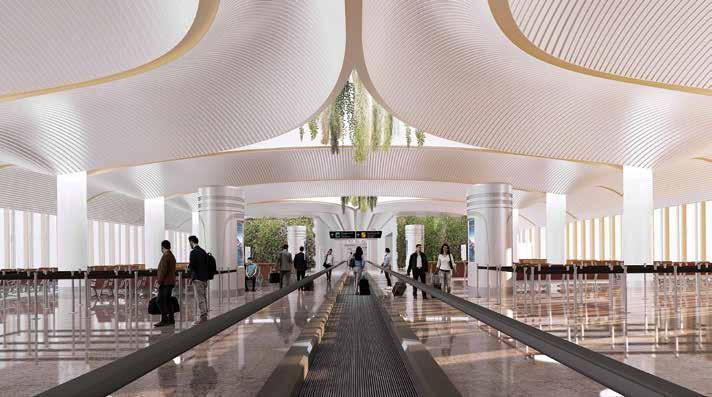
port will be via Metro line 2D: DN Nagar to Mandale – Mankhurd, metro line 8: Mumbai Airport to Navi Mumbai Airport and Navi Mumbai Pendhar Belapur Taloja metro line. In the future, there’s a plan to connect the airport through hovercraft from Colaba and through cargo from Raigad in Phase 2.
The airport will be the first in the country with automated passenger movement within its 1,600 hectares for 10 kms on the city side and on the airside.
Further City and Industrial Development Corporation (CIDCO) has proposed two new metro routes to boost connectivity within the Navi Mumbai Airport Influence Notified Area (NAINA) region. The first route is planned from the Ulwe coastal road to Ambivali in Raigad, focusing on accelerating connectivity from NAINA areas to NMIAL. The second proposed route under consideration is the Kalamboli-Chikhale-Kon corridor. This route
NMIAL will be connected via multimodal connectivity through metro, road, rail, and waterways making it India’s first airport with multimodal connectivity altering the complete transport paradigm of Mumbai and suburbs
will also improve accessibility to key locations like Taloja MIDC, Panvel, and neighbouring areas.
Thus, armed with best-in-class infrastructure and smooth connectivity from the airport to other parts of the city will encourage MNCs and early-stage startups to set up their offices in and around Panvel and adjoining areas thus carving Panvel and adjoining areas are commercial hotspots in the region.
TOURISM PARK. In an attempt to develop an entire aerocity eco-system around NMIAL, the government is keen to develop a tourism zone on 1,000 acres of land around the airport. This zone will have amusement parks, hotels, restaurants, hotel management and training institutes, and ancillary activities. The tourism zone is one of the provisions in the recent draft tourism policy for Maharashtra, expected to be tabled before the state cabinet.
As the Navi Mumbai International Airport gets operational which should most likely be towards the end of this year or Q1 of 2025, Mumbai will become the first city in the country to hold two international airports.
As the construction and growth of NMIAL is fast approaching the expected launch date, the complete surrounding area is expected to undergo a sea of change with economic development, creating fresh employment prospects and attracting investments not just in and around Mumbai and Suburbs but surrounding cities like Pune and Goa.
Sustainability is the new buzz word in aviation and every stakeholder, be it an airline, airport, OEM, MRO, ground handlers are vying for different means to adopt sustainable practices and meet their targets of carbon neutrality. Navi Mumbai airport however is set to make its mark in not only achieving its sustainable targets but being one of the top-ranking sustainable airports in the world. SP
SP’S AIRBUZ • ISSUE 2 • 2024 GWWW.SPSAIRBUZ.COM 18 NAVI MUMBAI AIRPORT AIRPORTS
Unlocking Economic Potential: NMIAL poised to create over 4 lakh job opportunities
The Sustainable Water-Injecting Turbofan Comprising Hybrid-Electrics (SWITCH) project is focused on developing a novel propulsion concept built from two revolutionary and synergetic technologies: Water-Enhanced Turbofan (WET) and hybrid-electric propulsion.

SUSTAINABLE AVIATION —
AN IMPORTANT GOAL
BY ROHIT GOEL
THE IMPERATIVE FOR THE commercial aviation sector to embrace sustainability has reached new heights. While currently responsible for a modest 2.4 per cent of global carbon dioxide (CO2) emissions, its share is poised to triple by 2050 amid burgeoning traffic and advancements in decarbonisation across other sectors. The industry’s pledge to achieve net-zero carbon emissions by 2050 demands significant strides in sustainable aviation fuels (SAF) and the adoption of more fuel-efficient aircraft. Despite projections of rapid SAF production growth, its high cost and current utilisation at a mere one percent of global jet fuel consumption underscore the challenges ahead. Dominated by key players such as Airbus and Boeing, alongside engine manufacturers General Electric Aerospace (GE), CFM, Pratt & Whitney, and RollsRoyce, the industry is witnessing concerted efforts to enhance fuel efficiency through innovative technologies. As a pivotal force for global connectivity and economic vitality, the aerospace sector is poised to spearhead the transition towards a carbon-neutral future, with these leading aviation OEMs standing fast in their commitment to lead this transformative journey.
Amidst growing concerns over environmental impact, leading OEMs across the aviation sector are dedicated to developing sustainable solutions to chart a course towards a cleaner, more sustainable future for air travel
BOEING’S LEADERSHIP IN AVIATION SUSTAINABILITY. At the forefront of aerospace innovation, Boeing spearheads sustainable solutions, anchoring its strategy on four pillars: fleet modernisation, renewable energy adoption, advanced technologies, and operational efficiency.
Boeing’s latest aircraft iterations signify substantial leaps in fuel efficiency. The 737 MAX, for instance, reduces fuel consumption and emissions by 20 per cent, enabling airlines to extend routes and payloads while minimising environmental impact. Similarly, the 787 Dreamliner boasts a remarkable 25 per cent enhancement in fuel efficiency, making it a preferred choice for environmentally conscious airlines.
Boeing recognises the pivotal role of Sustainable Aviation Fuel (SAF) in achieving net-zero emissions by 2050. Derived from renewable sources, SAF significantly slashes lifecycle carbon emissions. Boeing actively collaborates with fuel suppliers to ensure compatibility with existing aircraft, while supporting the development of SAF standards for broader adoption.
Innovation drives Boeing’s exploration of alternative propulsion systems. Electric and hybrid-electric systems show promise,
SP’S AIRBUZ • ISSUE 2 • 2024 19
PHOTOGRAPH MTU Aero Engines

particularly for short-range flights. Through partnerships like the Electric Powertrain Flight Demonstration programme with Aurora, Boeing aims to integrate megawatt-class electric propulsion systems into actual aircraft. Additionally, Boeing explores hydrogen fuel cells, leveraging its expertise in space technology for potential application in commercial aviation.
Boeing recognises that operational efficiency is pivotal in reducing emissions. Collaborating with air traffic control agencies globally, Boeing optimises flight paths to minimise fuel consumption. Initiatives like the ecoDemonstrator programme test innovative technologies such as sustainable cabin materials and fibre optic fuel sensors compatible with SAF.
Boeing acknowledges that a sustainable future demands collective action. Through forums like the Sustainable Aerospace Together Forum, Boeing collaborates with stakeholders to develop solutions. Tools like Cascade facilitate data-driven decision-making, empowering stakeholders to maximise sustainability efforts.
While SAF remains a frontrunner for decarbonisation, Boeing invests in electric, hydrogen, and advanced aircraft designs like the Transonic Truss-Braced Wing (TTBW). Recent acquisitions like Wisk Aero highlight Boeing’s commitment to exploring diverse avenues towards sustainability.
AIRBUS: CHARTING THE COURSE FOR SUSTAINABLE AVIATION. As a frontrunner in commercial aviation, Airbus is spearheading the transition towards a greener future with resolute determination and strategic initiatives. Grounded in innovative technologies and a steadfast commitment to environmental stewardship, Airbus is driving significant reductions in emissions across the aviation value chain.
Setting a bold precedent, Airbus has pledged to achieve netzero carbon emissions for its commercial aviation division by 2050. This audacious target necessitates a comprehensive approach, and Airbus is embracing the challenge head-on.The cornerstone
of Airbus’s sustainability strategy lies in the deployment of pioneering technologies and the adoption of cleaner fuel alternatives.
l Sustainable Aviation Fuel (SAF): Positioned at the forefront of sustainable aviation, Airbus champions the utilisation of SAF derived from renewable sources. By aiming for full certification of all commercial aircraft to operate on 100 per cent SAF by 2030, Airbus leads by example while actively promoting policies and collaborations to enhance SAF production and adoption.
l Hydrogen: Pioneering the Future of Flight: Beyond conventional alternatives, Airbus is revolutionising the industry with its ZEROe concept aircraft, powered by hydrogen fuel cells. This groundbreaking innovation is poised to realise the world’s first zero-emission commercial aircraft by 2035, supported by concerted efforts to develop essential infrastructure in collaboration with governments and research entities.
In tandem with its pursuit of alternative fuels and groundbreaking designs, Airbus remains committed to optimising existing technologies to maximise efficiency.
l Fleet Renewal: Through continuous innovation, Airbus designs aircraft models that surpass their predecessors in fuel efficiency, ensuring a seamless transition towards cleaner technologies as airlines renew their fleets.
l Operational Enhancements: Recognising the significance of operational practices in emissions reduction, Airbus collaborates closely with stakeholders to develop strategies that minimise fuel consumption through optimised air traffic management and flight operations.
In its quest for sustainability, Airbus explores a spectrum of propulsion technologies, including hybrid and electric options for shorter-haul flights, promising further advancements in emissions and noise reduction. Adopting a holistic perspective, Airbus integrates sustainability throughout the lifecycle of its aircraft, from material sourcing to disposal, and actively engages in industry-wide initiatives to promote sustainable aviation practices.
SP’S AIRBUZ • ISSUE 2 • 2024 GWWW.SPSAIRBUZ.COM 20 SUSTAINABILITY TECHNOLOGY
PHOTOGRAPH GE
Aurora to support hybrid electric flight demonstration programme
Aviation

CFM: SUSTAINABILITY GOALS AND THE RISE PROGRAMME.
CFM International, a joint venture between GE and Safran, is dedicated to advancing sustainable aviation technologies. Their mission is clear: to mitigate the environmental impact of air travel by prioritising reductions in fuel consumption and carbon dioxide emissions. At the forefront of this endeavour lies the Revolutionary Innovation for Sustainable Engines (RISE) programme, a cornerstone of CFM’s sustainability strategy.
Launched in June 2021, the RISE programme is strategically crafted to foster the development and demonstration of nextgeneration engine technologies, each with ambitious environmental objectives. These objectives include a targeted 20 per cent enhancement in fuel efficiency and a corresponding reduction in CO2 emissions, aiming to significantly curtail greenhouse gas contributions to climate change.
Moreover, the RISE programme underscores CFM’s commitment to alternative energy compatibility, particularly with cleanerburning fuels such as Sustainable Aviation Fuel (SAF). Additionally, the programme explores the feasibility of utilising hydrogen as a sustainable aviation fuel source, setting a precedent for future industry practices. Technological innovation is the hallmark of the RISE programme, with a focus on cutting-edge advancements in materials, engine core design, and fan architecture. From the integration of Ceramic Matrix Composites (CMC) to the adoption of resin-transfer-moulded composite fan blades, each innovation contributes to enhanced efficiency and durability.
A standout feature of the RISE engine is its open-fan architecture, which allows for unprecedented airflow and bypass ratios, leading to improved propulsive efficiency and reduced fuel consumption. Beyond RISE, CFM maintains a holistic approach to sustainability, continually refining engine design, manufacturing processes, and maintenance practices to minimise environmental impact throughout the engine lifecycle.
The RISE programme epitomises CFM’s unwavering dedication to sustainability, marking a pivotal step towards a greener future for air travel. Through relentless innovation and a commitment to environmental stewardship, CFM aims to redefine the aviation landscape, paving the way for a more sustainable and eco-conscious industry.
GE AEROSPACE’S
DEDICATION TO SUSTAINABLE
AVIATION. GE Aerospace stands at the forefront of sustainable practices within the aviation sector, exemplifying a steadfast commitment to environmental stewardship. Central to their sustainability endeavours is the GE9X turbofan engine, emblematic of their pursuit of ambitious ecological objectives.
At the heart of GE’s sustainability journey lies the GE9X turbofan engine, heralded as the epitome of fuel efficiency in its class. Through groundbreaking engineering, it significantly diminishes both emissions and fuel consumption, underscoring a paradigm shift towards a more eco-conscious operational paradigm for airlines embracing this technology. Recognising the imperative of relentless innovation, GE ventures beyond the GE9X, delving into a spectrum of advanced technologies poised to define the future of aviation sustainability:
l Open Fan and Hybrid-Electric Propulsion Systems: GE spearheads initiatives such as the CFM RISE programme and collaborates with NASA on megawatt-class hybrid-electric propulsion systems, charting a course towards unprecedented fuel efficiency and emission reduction.
l Compact Engine Cores: GE’s pursuit of compact engine cores aims to optimise efficiency further, potentially facilitating the development of inherently sustainable aircraft configurations.
l Alternative Fuels: Acknowledging the constraints of conventional jet fuel, GE champions the adoption of sustainable aviation fuel (SAF) and hydrogen as viable alternatives,
TECHNOLOGY SP’S AIRBUZ • ISSUE 2 • 2024 21 SUSTAINABILITY
GE Aerospace debuts new design for its hybrid electric aircraft test bed PHOTOGRAPH
GE Aerospace
offering a pathway to drastically reduce carbon footprint and achieve emissions neutrality.
Embracing hydrogen as the ultimate frontier of sustainability, GE collaborates with industry leaders like Airbus and CFMI to conduct groundbreaking flight tests of hydrogen-powered engines, marking a pivotal milestone towards realising emission-free air travel. Also, recognising the transformative potential of digital tools, GE is poised to leverage data-driven solutions to optimise engine performance, streamline flight operations, and enhance maintenance practices, thereby contributing significantly to emissions reduction and fuel conservation industry-wide.
PRATT & WHITNEY CHAMPIONS SUSTAINABLE
AVIATION WITH GTF INNOVATION. Responding to the urgent call for sustainable aviation solutions, Pratt & Whitney (P&W) is resolutely advancing a forward-looking strategy through their next-generation GTF (Geared Turbofan) engine technology. This proactive approach underscores their commitment to significant advancements in fuel efficiency and environmental stewardship within the aviation industry.
GTF – Revolutionising Aviation Efficiency:
l Fuel Efficiency Target: P&W aspires to achieve a minimum 10 per cent enhancement in fuel efficiency by the decade’s end, translating into substantial reductions in fuel consumption and carbon emissions.
l Enhanced Propulsive Efficiency: Central to the GTF plan is the expansion of fan diameter, facilitating a higher bypass ratio. This optimisation, targeting 14:1 compared to the current 12.5:1, ensures more effective engine power utilisation and reduced fuel consumption.
l Lightweight Construction: P&W is poised to introduce a 3D-woven composite fan, replacing conventional aluminium and titanium counterparts. This innovation promises a significant reduction in fan weight, thereby enhancing overall engine efficiency.
l Advanced Gear System: The GTF blueprint integrates an optimised fan-drive system gear ratio, enabling the engine to operate at peak efficiency, thereby further reducing fuel consumption.
P&W envisages up to a 5 per cent thrust increase in select engines by strategically elevating internal operating temperatures. To ensure safe operation under heightened thermal stress, the GTF programme incorporates cutting-edge advancements:
l High-Temperature Materials: Adoption of advanced materials like metal superalloys, Ceramic Matrix Composites (CMCs), and carbon-based materials fortifies the engine against heightened thermal stress.
l Intelligent Cooling Systems: P&W is pioneering intelligent cooling systems that deliver precise cooling air to engine blades throughout the flight cycle, optimising engine performance while curbing energy consumption for cooling.
Pratt & Whitney’s GTF technology blueprint epitomises a steadfast dedication to sustainable aviation. By prioritising fuel efficiency, emission reduction, and thrust augmentation, P&W emerges as a vanguard in forging environmentally conscious propulsion systems for the aviation industry’s future.
ROLLS-ROYCE: PIONEERING SUSTAINABLE AVIATION.
Rolls-Royce is not merely advancing engine technology; they’re shaping the future of aviation with sustainability at its core. Their ambitious objectives target achieving net-zero car-
bon emissions across their operations by 2030 and extending this impact to the sectors they serve by 2050. A testament to this commitment is the groundbreaking UltraFan programme.
The UltraFan engine stands as a testament to innovation. Boasting a record-breaking 140-inch fan diameter, it not only claims the title of the world’s largest engine but also prioritises Sustainable Aviation Fuel (SAF). Its inaugural ground test in May 2023, fuelled entirely by SAF, underscores its dedication to cleaner skies.
Rolls-Royce proudly declares that the UltraFan isn’t just the quietest engine ever built but also the most fuel-efficient, offering a remarkable 25 per cent improvement in fuel burn compared to its predecessor, the Trent XWB. This translates to substantial reductions in CO2 emissions, addressing a critical aspect of climate change.
Expected to be commercially available by 2030, the UltraFan represents a significant stride towards sustainable aviation, positioning Rolls-Royce as a frontrunner in fostering a greener future for air travel. The UltraFan programme is just one facet of RollsRoyce’s sustainability initiative. They are actively pursuing:
l 100 per cent SAF Compatibility: Committing to prove compatibility of all current Trent and Business Aviation engines with 100 per cent SAF by the end of 2023.
l Net Zero Products: Ensuring new Rolls-Royce products are geared for net-zero operation by 2030, with all products achieving this milestone by 2050.
Through a dedicated focus on cleaner technology and responsible fuel usage, Rolls-Royce demonstrates unwavering dedication to a sustainable future for air travel. The UltraFan programme epitomises how innovation can catalyse positive environmental change.
ADVANCING ELECTRIC AND HYBRID-ELECTRIC AVIATION.
The aviation sector is experiencing remarkable advancements in alternative propulsion systems, notably electric and hybrid-electric technologies. While electric aircraft contend with range limitations compared to conventional jet fuel, hybrid-electric setups present a viable solution by harnessing the strengths of both energy sources. These systems optimise energy efficiency and diminish fuel consumption by integrating a blend of jet fuel and electricity.
Recent collaborations, such as those between GE and NASA, have conducted pioneering tests on hybrid-electric propulsion systems, aiming to bolster performance at high altitudes. Furthermore, initiatives like the Sustainable Water-Injecting Turbofan Comprising Hybrid-Electrics (SWITCH) project, funded by the European Union, are propelling technologies like water-enhanced turbofans and hybrid-electric systems forward, promising substantial enhancements in fuel efficiency and emissions reduction.
Hydrogen emerges as another promising power source for aviation, offering superior energy density and emitting zero CO2 when derived from renewable sources. Airbus, in conjunction with partners like ArianeGroup, is spearheading hydrogenbased propulsion technologies, including hydrogen combustion and fuel cells, through its ZEROe concept. Similarly, startups like ZeroAvia and Universal Hydrogen are making significant progress with fuel cell-powered aircraft, heralding a more sustainable future for short-haul flights.
As the sector explores various propulsion alternatives, the shift towards renewable power sources underscores the imperative for green energy production methods to achieve substantial environmental advantages. SP
SP’S AIRBUZ • ISSUE 2 • 2024 GWWW.SPSAIRBUZ.COM 22 SUSTAINABILITY TECHNOLOGY

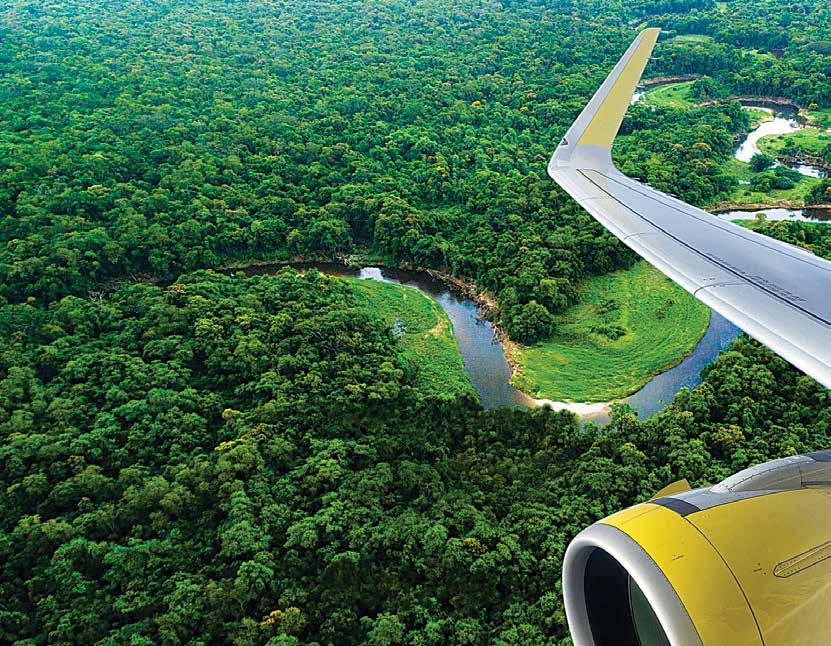
PRATT & WHITNEY: PIONEERING SUSTAINABLE AVIATION
BY AYUSHEE CHAUDHARY
With a legacy of groundbreaking innovations in aircraft propulsion spanning over ninety years, P&W continues to drive the industry towards a net-zero aviation CO2 emissions future by 2050
SP’S AIRBUZ • ISSUE 2 • 2024 23
PHOTOGRAPH Pratt & Whitney
Pratt & Whitney has been selected by the US Department of Energy (DoE) to develop novel, high-efficiency hydrogen-fueled propulsion technology for commercial aviation
IN AN ERA WHERE environmental sustainability is paramount, the aerospace industry faces the dual challenge of meeting growing demands for air travel while reducing its ecological footprint. As companies continue to take significant initiatives, Pratt & Whitney is among the leaders of this endeavour. Through innovative technology, greener business practices, and a steadfast commitment to environmental stewardship, Pratt & Whitney (P&W) is shaping the future of flight with a focus on sustainability through smarter technology, revolutionising and maximising efficiency. With a legacy of groundbreaking innovations in aircraft propulsion spanning over ninety years, P&W continues to drive the industry towards a net-zero aviation CO2 emissions future by 2050.
THE GTF ADVANTAGE. Pratt & Whitney leads in efficient singleaisle aircraft engines, investing in advanced technology like the gamechanging GTF engine introduced in 2016. Pratt & Whitney’s Geared Turbofan (GTF) engine, backed by over $10 billion in investment, has been a game-changer, delivering up to a 20 per cent improvement in fuel efficiency for single-aisle aircraft while significantly reducing NOx emissions and noise footprint. This technology has already made air travel more sustainable, saving millions of tonnes of CO2 emissions. The progress with the GTF Advantage marks the initial stride towards future propulsion systems aligned with aviation’s net-zero carbon emissions goal by 2050.
The Pratt & Whitney GTF Advantage engine for Airbus A320neo family aircraft takes efficiency to the next level, offering an additional one per cent improvement in fuel burn and CO2 emissions alongside greater thrust. This evolution demonstrates P&W’s commitment to advancing GTF architecture for large transport aircraft.
HYBRID-ELECTRIC PROPULSION.
Pratt & Whitney
Canada is at the forefront of hybrid-electric propulsion technology, aiming for a 30 per cent improvement in fuel efficiency with its regional aircraft demonstrator. Developed in collaboration with Collins Aerospace and De Havilland Aircraft of Canada, this initiative aims at optimising performance and reducing environmental impact in the future of aviation. Collaborative projects like SWITCH and STEP-Tech are developing hybrid electric propulsion systems for even greater efficiency gains, with potential CO2 emission reductions.
CLEANER FUEL. The transition to cleaner fuels emerges as a pivotal step towards achieving a net-zero future for civil avia-

TURBOPROP EFFICIENCY. The PW127XT-M engine for ATR 42/72 aircraft also sets new benchmarks in performance. With three per cent better fuel efficiency and lower CO2 emissions, along with reduced maintenance costs and extended time on wing, the turboprop engines offer unparalleled sustainability advantages.
Collaborating with industry partners, P&W is working towards enabling the use of 100 per cent SAF in the future
tion. Pratt & Whitney continues to develop smarter technologies to aid this transition, advancing the use of Sustainable Aviation Fuels (SAF) and pioneering technologies to support alternative, zero-carbon fuels like hydrogen.
SAF-READY. Pratt & Whitney engines are primed to operate with SAF blends of up to 50 per cent with Standard Jet A Kerosene. These stand on the strong base of P&W’s role in defining technical standards for SAF blends and their involvement in SAF testing and certification that spans decades. Collaborating with industry partners, P&W is working towards enabling the use of 100 per cent SAF in the future, ensuring compatibility with nextgeneration engines like the GTF Advantage.
HARNESSING HYDROGEN POWER. Hydrogen, with its energy-rich and carbon-free properties, holds immense potential for enabling zero-emissions flight. Despite challenges, P&W believes that their extensive expertise in hydrogen-fueled propulsion systems position them well to navigate this frontier. The Hydrogen Steam-Injected, Inter-Cooled Turbine Engine
SP’S AIRBUZ • ISSUE 2 • 2024 GWWW.SPSAIRBUZ.COM 24
SUSTAINABILITY ENGINES
Pratt & Whitney has been closely involved in SAF testing for over a decade and have tested 100 per cent SAF in various engines
PHOTOGRAPH Pratt & Whitney
SUSTAINABILITY ENGINES
(HySIITE) project embodies P&W’s commitment to innovation in hydrogen-fueled propulsion. By optimising engine design to leverage the unique cryogenic properties of hydrogen, HySIITE aims to achieve zero in-flight CO2 emissions, an 80 per cent reduction in nitrogen oxide emissions, and up to a 35 per cent decrease in fuel consumption for next-generation single-aisle aircraft.
ADVANCED TECHNOLOGIES. Revolutionary materials like Ceramic Matrix Composites (CMCs) are enhancing engine efficiency by withstanding higher temperatures and reducing fuel consumption. Electrification efforts, such as the Scalable Turboelectric Powertrain Technology (STEP-Tech) demonstrator, offer complete or partial electrification solutions for aircraft of vari-
ability. Through investments in connected factories, automation, and advanced process control, the company is driving improvements in manufacturing effectiveness while reducing environmental impact.
l Exemplary Facilities: Pratt & Whitney’s new airfoil production facility in Asheville, North Carolina, exemplifies its modernisation efforts. This state-of-the-art, vertically integrated facility utilises highly automated processes to streamline production, reducing transportation distances and handoffs while enhancing efficiency.
l LEED Certified Buildings: Pratt & Whitney boasts 14 LEED Silver or better certified buildings globally, demonstrating its commitment to sustainable building practices across its operations.

ous sizes. Hybrid-electric propulsion (HEP) technology, demonstrated in a modified De Havilland Canada Dash 8-100 regional jet, promises up to 30 per cent fuel burn reduction compared to existing turboprops.
GREENER BUSINESS PRACTICES. While Pratt & Whitney remains dedicated to advancing sustainable aviation through innovative propulsion technology, the company equally prioritises reducing its environmental impact through greener business practices including:
l 2025 Environment, Health & Safety Goals: Pratt & Whitney’s commitment to sustainability includes energy efficiency enhancements, expanding renewable energy usage, and minimising landfill waste and water consumption. Since 2006, the company has significantly reduced greenhouse gas emissions, increased waste recycling, and achieved double-digit reductions in annual water usage.
l Industry 4.0 Transformation: Embracing the principles of Industry 4.0, Pratt & Whitney is modernising its global manufacturing operations to enhance efficiency and sustain-
l Green Factory Forums: Pratt & Whitney fosters knowledge-sharing and innovation through Green Factory Forums, where manufacturing facilities exchange best practices in sustainability, from utility management to waste reduction.
l Best Management Practices: Pratt & Whitney and Raytheon Technologies have implemented Best Management Practices (BMPs) to guide facilities in waste management, recycling, and environmental stewardship, ensuring alignment with shared sustainability goals.
l Social Initiatives: Committed to supporting both the environment and communities, Pratt & Whitney integrates key social initiatives into its programmes, leveraging its industry position for positive societal impact.
l Materials of Concern Reduction: Pratt & Whitney’s Green Engine Programme, initiated in the 1990s, has been instrumental in minimising Materials of Concern (MOC) in engine design, manufacturing, and maintenance. The company continues to invest in green technologies, including those of its suppliers, to further reduce environmental impact.
RECENT UPDATES TOWARDS THE SUSTAINABLE ROUTE. IAE tests
V2500 engine: IAE International Aero
HySIITE aims to achieve zero in-flight CO2 emissions, an 80 per cent reduction in nitrogen oxide emissions, and up to a 35 per cent decrease in fuel consumption for nextgeneration single-aisle aircraft
SP’S AIRBUZ • ISSUE 2 • 2024 25
PHOTOGRAPH ATR
EASA certifies ATR’s regional turboprop aircraft powered by new PW127XT-M engine
SUSTAINABILITY ENGINES
Engines AG (IAE), a consortium including Pratt & Whitney, successfully tested the V2500 engine with 100 per cent SAF at MTU Maintenance Hannover, Germany. The engine powers A320ceo family aircraft and the Embraer C-390 Millennium, offering fuel efficiency and emissions advantages. The test used Hydroprocessed Esters and Fatty Acids Synthetic Paraffinic Kerosine (HEFA-SPK) fuel supplied by Neste, a sustainable alternative to conventional jet fuels. Pratt & Whitney collaborated with CAAFI and ASTM International to develop specifications for 100 per cent SAF.
Greener operations: Pratt & Whitney’s emphasis on sustainability in its operations is evident in new facilities in Carlsbad, California, and Asheville, North Carolina. The Asheville site, featuring advanced casting foundry and airfoil production, exceeds
to 50 per cent, with plans for 100 per cent SAF readiness. Recent tests, including with the GTF Advantage engine, demonstrate progress in this area. Additionally, Pratt & Whitney is pioneering hydrogen propulsion technology through projects like HySIITE, aiming for zero CO2 emissions and significant fuel consumption reduction. Despite infrastructure challenges, Pratt & Whitney remains committed to advancing sustainable aviation solutions. Pratt & Whitney is also pioneering hydrogen propulsion, with decades of experience in hydrogen-burning turbine engines.
THE PATH AHEAD.
Pratt & Whitney is at the forefront of sustainable flight, advancing engine technologies and fuel efficiencies to meet the goal of net-zero CO2 emissions by 2050. Pratt & Whitney is investing in technology programmes as well as people to achieve these goals.

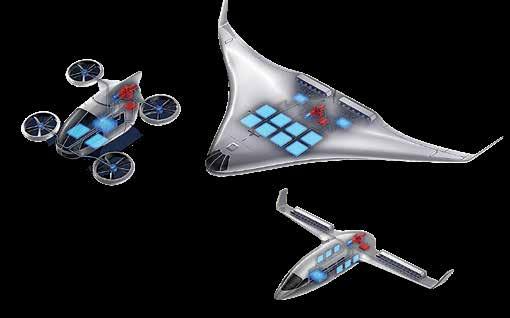
goals for greenhouse gas, water, and waste reduction. Carlsbad focuses on reducing its carbon footprint with on-site heat reclamation and power generation. As part of Raytheon Technologies, Pratt & Whitney sets EH&S goals to reduce emissions, water usage, and waste. Collaboration and innovation drive their commitment to a smarter, cleaner, and greener aviation future.
SAF shift & Hydrogen hike: Pratt & Whitney supports the shift to cleaner fuels like SAF. All engines are SAF-compatible up
Collaborative projects like SWITCH and STEP-Tech are developing hybrid electric propulsion systems for even greater efficiency gains, with potential CO2 emission reductions
The scalable geared architecture has laid the groundwork for future propulsion systems, exemplified by ongoing efforts such as the GTF Advantage. The progress with the GTF Advantage marks the initial stride towards future propulsion systems aligned with aviation’s net-zero carbon emissions goal by 2050. Collaborating with Collins Aerospace, Pratt & Whitney is pioneering sustainable solutions for regional aircraft, including the RTX hybrid-electric flight demonstrator programme. While hybrid-electric propulsion is in early stages, it holds promise for achieving net-zero carbon emissions by 2050, alongside advancements in battery technology and sustainable aviation fuels. Within RTX, Pratt & Whitney and Collins Aerospace have collaborated on sustainable solutions tailored for regional aircraft, including hybrid-electric propulsion technology and a flight demonstrator programme. A significant milestone was achieved with last year’s successful rated power test of the demonstrator’s 1-megawatt electric motor developed by Collins. This motor, coupled with a highly efficient thermal engine from Pratt & Whitney, aims to showcase a 30 per cent improvement in fuel efficiency and CO2 emissions over current regional turboprops.
When it comes to India, Pratt & Whitney is confident that India’s industry and technology will play a crucial role in shaping this sustainable flight future, driving Pratt & Whitney’s continued success through increased investments and collaboration. Testing for unprecedented performance levels is underway, with expectations of its appeal in the Indian market. P&W’s impact in India transcends powering over 600 aircraft, encompassing advancements in aerospace and defence through investments in engineering, training, supply chain, digital capabilities, and innovation.
As Pratt & Whitney continues to lead the charge towards a more sustainable aviation future, its efforts serve as a beacon of hope for the entire aerospace industry. By prioritising smarter technology, cleaner fuels, and greener business practices, Pratt & Whitney is constantly aiming to transform the way we fly while also ensuring a healthier planet for future generations. SP
SP’S AIRBUZ • ISSUE 2 • 2024 GWWW.SPSAIRBUZ.COM 26
Pratt & Whitney and Collins Aerospace Expand Leadership in Hybrid-Electric Propulsion Technology with New STEP-Tech Demonstrator
PHOTOGRAPH Pratt & Whitney
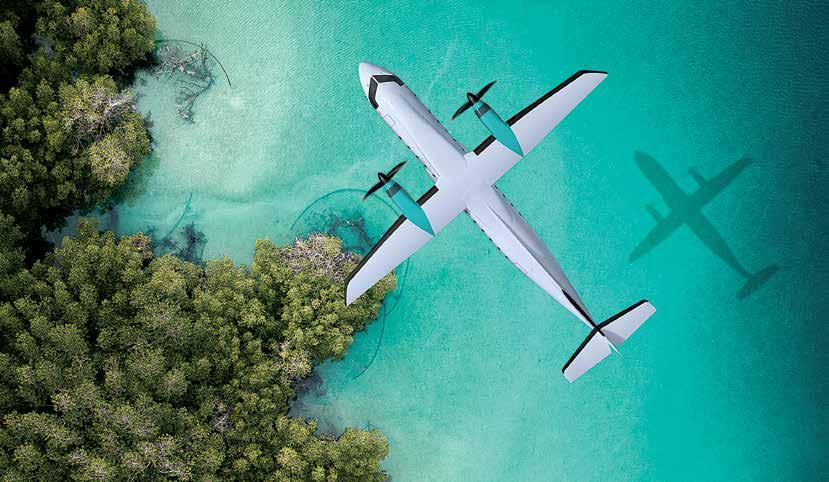
INNOVATING AIR TRAVEL FOR TOMORROW’S SKIES
Jayant Baranwal (Jayant): Hello Anastasija, thank you for joining us today. Can you provide us with a brief background of Deutsche Aircraft and your journey since its inception?
Anastasija Visnakova (Anastasija): Certainly, Jayant. Deutsche Aircraft’s roots can be traced back to the renowned heritage of Dornier. Our current in-service legacy D328 JET and Turboprop aircraft are driving innovation for the new regional turboprop D328eco, which stands as one of the most versatile near climate-
Deutsche Aircraft, headquartered in Germany, is leading the way to more sustainable flying as part of a future of integrated regional transportation solutions. In an interview to Jayant Baranwal, Editor-in-Chief of SP’s AirBuz, Anastasija Visnakova, Vice President of Sales & Marketing at Deutsche Aircraft, traces the journey of the company and explores its sustainable path forward
neutral aircraft in the market. We are innovating regional aviation with a more sustainable approach for more integrated transport solutions in any region across the globe.
I joined Deutsche Aircraft as Vice President in Sales and Marketing two years after its inception. Since then, we’ve been actively engaged in sales activities, targeting regions and markets where we can make a significant difference with our innovative approach and the D328eco.
SP’S AIRBUZ • ISSUE 2 • 2024 27 DEUTSCHE AIRCRAFT EXCLUSIVE INTERVIEW
PHOTOGRAPHS
The D328eco platform isn’t limited to just specialised missions, it’s also well-suited for corporate and business aviation
: Deutsche Aircraft
Jayant: That’s fascinating. Now, could you share some details about your complete family of aircraft?
Anastasija: Absolutely. As Deutsche Aircraft, we’re focused on building the D328eco, the next generation of the Dornier 328 turboprop. Here are some key facts about our new platform: it accommodates 40 passengers, boasts 800m STOL capabilities with a 70 per cent load factor, and offers a long-range speed of 324KTAS.
Compared to the in-service Dornier 328 Turboprop, the D328eco provides 14 per cent fuel savings per passenger and reduces up to 50 per cent direct maintenance costs per flight hour.
The new PW127XT-S engine brings remarkable improvements to the D328eco. With 40 per cent longer time on wing, operators can enjoy extended operational hours before maintenance intervals, ensuring greater efficiency and reliability. Additionally, there’s a 20 per cent reduction in maintenance costs, requiring only two shop visits within the first 10 years of service. Plus, a 3 per cent less fuel burn, this not only streamlines operations but also minimises downtime and expenses.

Jayant: Impressive indeed. Now, let’s talk about sustainability. How do you claim that D328eco is the future of zero emissions, and what are its key features in this regard?
Anastasija: The D328eco will be manufactured in an innovative and climate-friendly CO2-neutral final assembly line, powered by renewable and solar energy. It will run on 100 per cent sustainable aviation fuel (SAF) and power-to-liquids (PtL) compatible fuels, offering a pathway towards reducing emissions. Power-to-Liquids can be produced from renewable sources and can replace conventional jet fuel, utilising existing infrastructure at airports. Our ambition is to maximise environmental benefits by flying on 100 per cent PtL with zero aromatics, potentially reducing the climate effects of contrails.
Jayant: Thank you for elaborating on that. Now, from your perspective, how would you define “Regional” aircraft, and what role do they play?
Furthermore, the D328eco stands as a versatile aircraft platform, adaptable to a wide array of multi-role missions. Whether it’s air ambulance services for medical evacuations, regional commuter flights, search and rescue operations, aerial firefighting missions, or maritime surveillance tasks, the D328eco excels. Its flexibility and capabilities make it an ideal choice for various specialised roles, catering to diverse operational needs.
Moreover, the D328eco platform isn’t limited to just specialised missions; it’s also well-suited for corporate and business aviation.
Anastasija: Regional aircraft are essential for connecting local economies that lack proper infrastructure. They enable transportation integration, reaching even the most remote places under rugged conditions. Typically seating up to 50 passengers, these aircraft are lifelines for many communities, fostering economic growth and connectivity.
Jayant: Interesting. Can we presume D328eco will not only serve the commercial airlines around the world but also various business aircraft operators too? Do you offer any unique composition of travel to potential business aviation travellers?
D328MR: THE MULTI-ROLE PLATFORM FOR THE FUTURE
ADAPTABLE TO YOUR NEEDS
Flexible and versatile configurations

Highly adaptable Garmin avionics suite
Ready for various missions
TAKE OFF AND LAND ANYWHERE
Great STOL performance
Steep approach capability
Unpaved runway capability
SUSTAINABLE DESIGN
100% SAF-PtL compatible
Highly efficient Pratt & Whitney PW127XT-S engines
Materials and processes are REACH compliant
GLOBAL CUSTOMER SUPPORT
More than 15 years of global experience
24/7 customer and product support

Providing Endless Multi-Role Configurations & Unmatched Performance
UP To 12 h of in-flight operations
100% SAF compatible
99.8 % dispatch reliability globally*
QUICK 4 h cabin conversion capability
BEST-IN-CLASS COC and DMC
*Target DR for D328MR
EXCLUSIVE INTERVIEW SP’S AIRBUZ • ISSUE 2 • 2024 GWWW.SPSAIRBUZ.COM 28 DEUTSCHE AIRCRAFT
Anastasija Visnakova, Vice President of Sales & Marketing at Deutsche Aircraft
“Our new regional turboprop D328eco stands as one of the most versatile near climateneutral aircraft in the market.”
Anastasija: It is a very good question and a legitimate one. The D328eco can be configured to any purpose from commercial passenger aircraft to multi-role operations. There are the multi-role variants of the D328eco which can be configured from cargo carrier to search and rescue. The cabin of the D328eco is versatile to serve any purpose so business aviation is also at the core of what our product can offer.
The fleet of the up to 50 seat Turboprop is globally ageing. Most of the aircraft currently are used for regional passenger flights. The D328eco is the perfect tool to increase profits by replacing old aircraft. Here we do see a strong demand, but also additional demand in growing markets like the APAC region.
Jayant: Thank you for clarifying that. Now, about the choice of propulsion systems, why did you opt for a turboprop, and how does it cater to different operator preferences?
Anastasija: The reason is quite simple: this is the most efficient and sustainable propulsion system available on the market. And on top of that, it offers outstanding climb and ceiling performance, at 30,000 feet excellent STOL performance without compromising on speed. The D328eco will be the fastest Turboprop in its class.
In consequence we do see more market interest in the turboprop which address their needs to their current operational needs.
Jayant: There’s one basic difference between the Turboprop and the Jet, if I can say, one goes within the weather, flies within the weather, the other, the Jet flies above the weather. Is that correct? Does it apply to your aircraft also?
Anastasija: Indeed, that’s a very good question. Our aircraft is

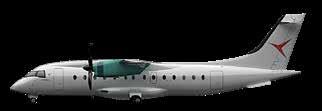
*Data based on 40 PAX configuration
certified to a 30,000 feet ceiling, allowing it to fly above weather, as you rightly said. This sets it apart in terms of performance, boasting outstanding capabilities. Additionally, it features a fully-pressurised cabin equipped with oxygen masks for passengers. So, while it may not adhere to the conventional image of a turboprop, it operates above the weather, which enhances its eco-performance. This makes it particularly suitable for regions with mountainous terrain. The aircraft was designed with global operability in mind, ensuring it can operate effectively in diverse environments. So, as I said the performance of the aircraft is outstanding and really stands out.
Jayant: I’ve heard that one big advantage of the Turboprop is its efficiency compared to a Jet. Is that true?
Anastasija: Absolutely. I fully agree with you. Turboprops, including ours, offer significant efficiency advantages over jets. They consume much less fuel, which not only reduces costs but also enhances sustainability. This is a considerable asset and gives turboprops a distinct advantage in various operational scenarios.
Jayant: Would you share some details on 328 support services? Since time is the paramount factor in flawless operations of the aircraft, can you tell us how effectively the solution/ supply of any part/ any repair is handled around the globe? What is the cut-off timing to expedite the response to your operators for their after-sales service/ repair calls?
Anastasija: At Deutsche Aircraft, we have extensive experience with Dornier aircraft, offering comprehensive services for the D328 series, including major modifications and upgrades. We continue to serve our current operators under the same name, ensuring continuity and reliability.
We have evolved from the 328 Support Services GmbH (328SSG) and we still have the Type Certificate (TC) rights for the Dornier 328 platform (D328).
As the TC holder of the D328, we continue to serve in-service fleet for continuity, supporting the global fleet of around 150 inservice D328 aircraft. The team’s daily operations encompass customer & technical support, including design engineering and

EXCLUSIVE INTERVIEW SP’S AIRBUZ • ISSUE 2 • 2024 29 DEUTSCHE AIRCRAFT
DIMENSIONS 23.31 m / 76.5 ft 7.24 m / 23.8 ft 2.18 m / 85.8 in 1.86 m / 73.2 in EXAMPLE INTERIOR LAYOUT
training to ensure the aircraft remains ahead of its class.
Deutsche Aircraft also strong collaboration with Simulator Training Solution GmbH (STS) to provide training for current D328 operators as part of supporting continuous operation of in-service fleet.
Jayant: That sounds like a robust support system. Now, why do you call Deutsche Aircraft a premium aircraft producer?
Anastasija: Deutsche Aircraft stands out as a premium aircraft producer due to our commitment to excellence and sustainability. We’re building the D328eco in a carbon-neutral final assembly line and offering top-quality services to our customers. Moreover, our partnerships with organisations like the German Aerospace Centre underscore our dedication to driving innovations for climate-neutral flights in 2050. Our German heritage from Dornier further enhances our reputation as a leader in clean energy aviation.

We take great pride in our work, drawing upon our rich heritage in aircraft manufacturing to distinguish ourselves through our D328eco product. Our aim is to be acknowledged as pioneers in innovation, clean energy, and product excellence and our vision extends to leading the charge in sustainable aviation, thereby fostering the advancement of more comprehensive regional transportation solutions.
Jayant: Impressive accolades indeed. Now, in a rapidly evolving aviation landscape, how do you position your aircraft amidst other innovations like electric/hybrid platforms and eVTOLs?
“The D328eco will be manufactured in an innovative and climate-friendly CO2-neutral final assembly line, powered by renewable and solar energy.”
Anastasija: Our R+T team diligently monitors and tests new disruptive propulsion technologies, such as electric/hybrid aviation platforms, with a focus on assessing their potential value for our customers. The development of the D328eco is the direct outcome of this thorough evaluation process.
Our market targeting strategy revolves around identifying regions where integrated regional mobility can be achieved without substantial infrastructure investments. Our goal is to offer an adaptable aircraft solution tailored to the unique demands of each market.
Additionally, we aim to empower operators worldwide to contribute to environmental preservation by utilising Sustainable Aviation Fuel (SAF) and Power-to-Liquid (PtL) technologies whenever feasible.
Beyond the D328eco, we’ve embarked on a partnership with the German Aerospace Agency (DLR) to transform a D328 into a flying testbed. This collaborative effort seeks to explore future propulsion technologies for the benefit of the entire industry.
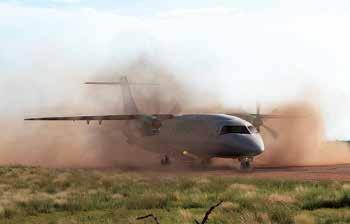
Jayant: That’s forward-looking indeed. Finally, what are your key market targets globally?
Anastasija: We’re not confined to specific regions; our target markets encompass regional connections worldwide in the up to 50-seater segment. We aim to serve diverse markets with our versatile aircraft platform.
Certainly, having gained experience across various facets of aviation, I possess a comprehensive understanding of both airline operations and Original Equipment Manufacturer (OEM) dynamics. From a commercial standpoint, airlines typically choose their fleets based on operational efficiency. To be part of a company offering a product like the D328eco, the next-generation turboprop, presents a unique opportunity. This aircraft is not only highly efficient but also designed to be 100 per cent compatible with sustainable aviation fuel (SAF) and Power-to-Liquid (PtL) synthetically produced liquid hydrocarbon. This aspect motivates me to advocate for a product that has the potential to significantly advance the industry towards achieving near climate-neutral objectives.
Jayant: Thank you, Anastasija, for sharing your insights with us today. Your commitment to sustainability and innovation is truly commendable. We wish Deutsche Aircraft continued success in its endeavours. SP
EXCLUSIVE INTERVIEW SP’S AIRBUZ • ISSUE 2 • 2024 GWWW.SPSAIRBUZ.COM 30 DEUTSCHE AIRCRAFT
(Left-Right) The D328eco aims to serve diverse markets with a versatile aircraft platform that can tailored to the unique demands of each market
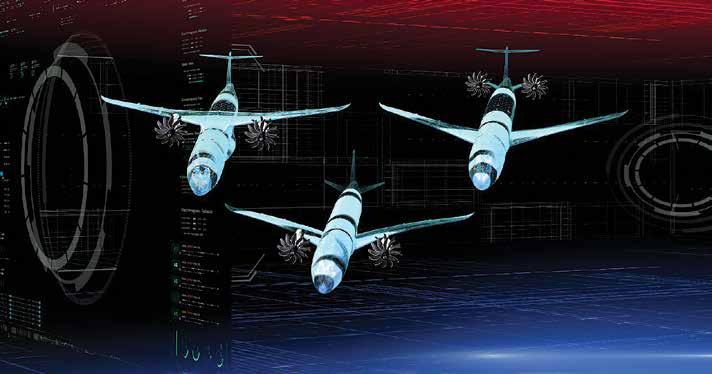
POWERING THE FUTURE
BY SP’S STAFF CORRESPONDENT
CFM INTERNATIONAL, A GLOBAL leader in aircraft engine manufacturing, hosted a highly anticipated media briefing on the eve of the Singapore Airshow 2024, to unveil its latest advancements in engine technology for narrowbody aircraft. The event featured comprehensive presentations from key executives including Arjan Hegeman, General Manager of Advanced Technology at GE Aerospace, and Pierre Cottenceau, VP of Engineering, Research & Technology at Safran Aircraft Engines.
CFM International showcased its unparalleled expertise and track record as a world-leading engine supplier, highlighting the exceptional performance and reliability of its CFM56 and LEAP engines. With over 33,000 engines delivered and a backlog of 10,500 LEAP engines, CFM International continues to dominate the market, powering a vast fleet of Airbus A320neo, Boeing 737 MAX, and COMAC C919 family aircraft worldwide.
The company reaffirmed its unwavering commitment to sustainability, unveiling groundbreaking advancements aimed at enhancing efficiency and reducing environmental impact. Noteworthy achievements include a remarkable 40 per cent reduction in fuel consump-
CFM International showcases its RISE next-generation engine architecture that aims to revolutionise engine design, targeting lower noise levels and achieving 100 per cent SAF certification
tion since the introduction of the CFM56 engine, underscoring CFM International’s relentless pursuit of efficiency excellence.
THE RISE PROGRAMME. The CFM Revolutionary Innovation for Sustainable Engines (RISE) programme is a groundbreaking initiative, poised to revolutionise the aviation industry. Designed to embody the principles of innovation, sustainability, and efficiency, the RISE programme represents a significant leap forward in engine technology, with a focus on next-generation engine architecture. This initiative aims to revolutionise engine design, targeting lower noise levels and achieving 100 per cent Sustainable Aviation Fuel (SAF) certification. The company is committed to developing cutting-edge technologies that will shape the future of sustainable aviation.
l The Technology Behind RISE: At the core of the RISE programme lies a suite of cutting-edge technologies aimed at redefining the future of aviation. Leveraging next-generation architecture and engineering prowess, RISE engines boast a step-change in efficiency compared to traditional ducted fan engines. One of the most notable advancements is the incor-
SP’S AIRBUZ • ISSUE 2 • 2024 31 ENGINES TECHNOLOGY
The CFM Rise programme demonstrates a range of new, disruptive technologies like Open Fan Architecture and Hybrid Electric Capability for Future Engines
PHOTOGRAPH
Safran Group
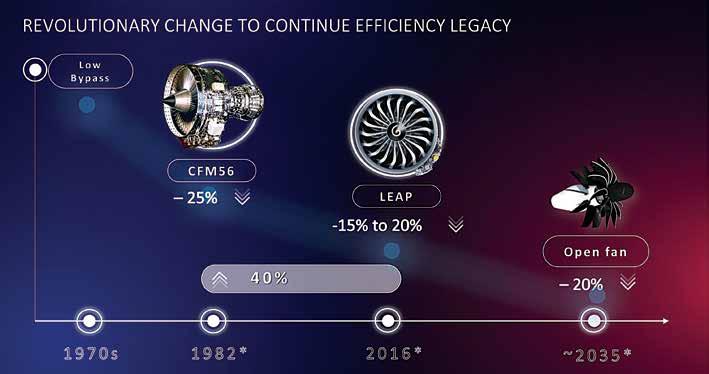
poration of an open fan, low bypass design, which enables a significant reduction in fuel consumption and emissions. CFM International’s RISE engines represent a paradigm shift towards more sustainable and eco-friendly air travel.
l Status of the Programme: The RISE programme has made remarkable progress since its inception, with extensive testing and development efforts underway. CFM International has completed a series of rigorous tests to validate the performance and reliability of RISE engines, including comprehensive aerodynamics and acoustics evaluations. Major milestones, such as fan blade tests, wind tunnel tests, and turbine tests, have been successfully completed, demonstrating the readiness of RISE technologies for ground and flight testing.
l Schedule: CFM International is on track to conduct ground and flight tests of RISE engines throughout the current decade. The programme timeline includes early part-level testing in the mid-2020s, followed by ground tests and flight tests in the 2030s. With a robust conceptual design review completed in 2022, CFM International is well-positioned to accelerate the development and deployment of RISE engines in the coming years.
The RISE programme embodies CFM International’s unwavering commitment to pushing the boundaries of innovation and
The RISE programme embodies CFM International’s unwavering commitment to pushing the boundaries of innovation and sustainability
sustainability in the aviation industry. Through relentless research, development, and collaboration, CFM International aims to pave the way for a greener, more efficient future of air travel.
INVESTMENT IN ALTERNATIVE FUELS
CFM International reiterated its commitment to exploring alternative fuels, with a particular focus on hydrogen propulsion. The company is actively developing next-generation compressor technologies and materials to optimise the performance of hydrogen-powered engines. Through strategic investments and partnerships, CFM International is driving the adoption of sustainable aviation fuels and advancing the industry towards decarbonisation.
Arjan Hegeman, General Manager of Advanced Technology at GE Aerospace, expressed his enthusiasm for CFM International’s groundbreaking initiatives, stating, “CFM International is at the forefront of innovation in the aviation industry. Our commitment to sustainability and efficiency drives us to develop groundbreaking technologies that will shape the future of air travel.”
Pierre Cottenceau, VP of Engineering, Research & Technology at Safran Aircraft Engines, echoed Hegeman’s sentiments, emphasising the importance of collaboration and innovation in realising CFM International’s ambition towards decarbonisation. “We are proud of the progress we have made in realising our ambition towards decarbonisation,” said Cottenceau. “Through collaboration and innovation, we are laying the foundation for a more sustainable aviation industry.”
CFM International is a joint venture between GE Aviation, a division of General Electric Company, and Safran Aircraft Engines, a subsidiary of Safran Group. The company is a leading supplier of commercial aircraft engines, powering more than 600 airline customers worldwide. It’s state-of-the-art testing facilities and collaborative efforts with industry partners underscore its commitment to safety and innovation. SP
SP’S AIRBUZ • ISSUE 2 • 2024 GWWW.SPSAIRBUZ.COM 32 ENGINES TECHNOLOGY
Since CFM56 EIS REDUCTION PHOTOGRAPH CFM REVOLUTION



SP’S MILITARY YEARBOOK 2021-2022 CONTENTS HEREWITH ALL NEW - SP’S MILITARY YEARBOOK 21-2022 • AN INDISPENSABLE REFERENCE DOCUMENT * MOST UPDATED INDIA’S WHO’S WHO IN DEFENCE, MOST UPDATED ASIA’S WHO’S WHO IN DEFENCE & MUCH MORE.... SP’s Military Yearbook 2021 –2022 GET YOUR COPIES, NOW: E-mail us at order@spsmilitaryyearbook.com WhatsApp us at +91 97119 33343 Call us on +91 11 24644693, 24644763, 24658322 Connect via : @SPsMYB www.spsmilitaryyearbook.com


NOW AVAILABLE Get your copies now: order@spscivilaviationyearbook.com or at +91 97119 33343





























































